100+ Statistics on Crime in US Schools
- Crime in US Schools at a Glance
- Bullying in US Schools
- Violent Crimes & Theft
- Lethal Violence & School Shootings
- Hate Crimes & Racism
- Drug & Alcohol Abuse
- Geographical Differences
- The Impact of COVID-19 on School Crime
- Contributors to School Crime
- Tips to Prevent School Crime & Violence
- The Bottom Line
As people around the United States reacquaint themselves with normal life, there's one glaring social issue that the COVID-19 pandemic seems to have relegated to the backburner: school crime.
Such an important problem deserves a comprehensive data-driven guide. That's why we're bringing you 100+ statistics on crime in US schools.
School crime — and, in particular, school shootings — has been a prevailing topic of conversation across the United States for many years. High-profile incidents have only added fuel to the fire.
In 2020, schools closed their doors following COVID-19 lockdowns. Classrooms and once-crowded hallways were empty, and the issue of school crime seemed to all but disappeared too. Only it didn't.
To update you on the current state of play, we've put together a hefty list of statistics on all things school crime. We'll cover the prevalence of school shootings, violence, bullying, the effect of COVID-19, and much more.
Plus, we've added a few tips to help minimize the risk of crime in US schools.
Crime in US Schools at a Glance
First, let's familiarize ourselves with some general statistics. How unsafe are schools? Are school crime rates getting worse? And what kind of crimes do students commit?
1. Have Schools Become Less Safe?
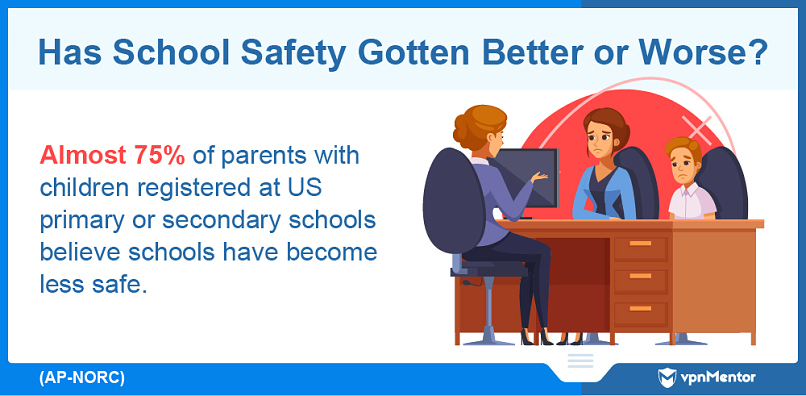
Most American parents believe schools are less safe now than they were 20 years ago. This view is fueled by a general lack of confidence in schools' ability to respond to active shooter incidents. Just 31% of parents are "very confident" in their child's school's response.
Recent incidents have thrust school shootings firmly into the public conscience. But when we look deeper into the prevalence of every type of crime in US schools, are parents' fears justified?
2. Many Students Fear Victimization at School
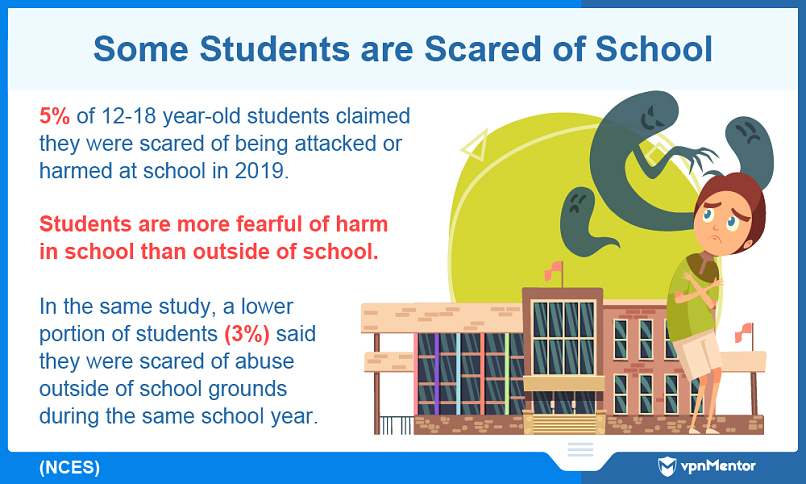
School can be stressful for most students, especially if there's the added anxiety that one could face bullying, violence, or hate speech.
Students may feel more vulnerable away from the protection of their parents. While school crime rates are comparable to those outside, the fear of victimization some students bear isn't unfounded.
3. The Majority of Schools Report Crime
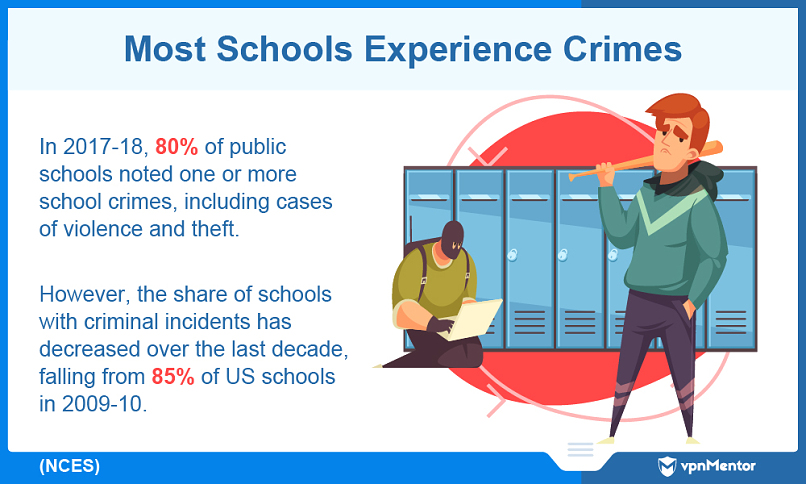
Crime is a part of everyday school life for many students. Most schools experience criminal activities throughout the school year, with 80% of schools reporting incidents in 2017-18.
4. How Many Students Experience Crime in US Schools?
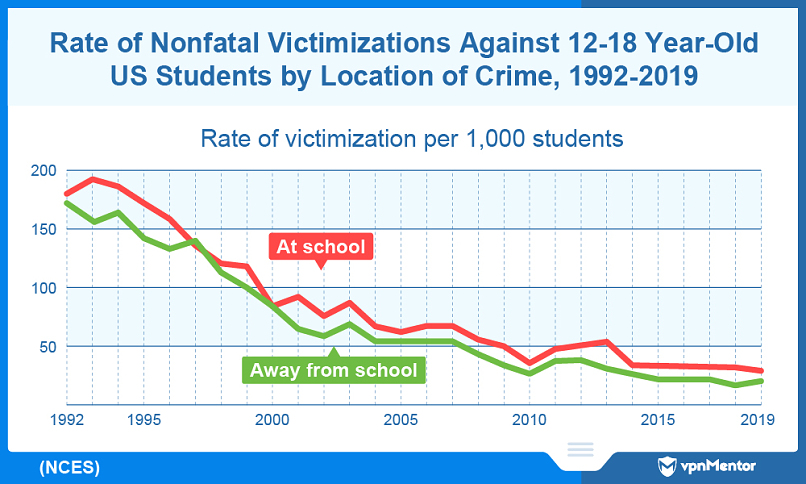
| Nonfatal Victimization | Any instance of theft, rape, sexual assault, robbery, aggravated assault, and simple assault. |
| “At School” | In NCES graph titles, “at school” refers to any incident that occurs in school buildings, on school property, on school buses, or during travel to and from school. |
| Simple Assault | Attack upon a person excluding incidents where a weapon is used or serious injury is inflicted. Also includes attempted assault. |
| Aggravated Assault | Attack upon a person that inflicts serious injury or bodily harm, or any attempted attack with a weapon, regardless of whether or not the victim is injured. |
Note: All crime definitions are taken from the National Center for Education Statistics (NCES) glossary and apply to data presented by the NCES.
Data from the US Department of Education's most recently studied year (2019) shows that the rate of nonfatal victimizations in schools has fallen over the last 20-30 years. Nonfatal victimization includes the most common crimes, excluding counts of homicide.
In 1992, there were 181 total nonfatal victimizations at school per 1,000 12-18 year-old students. In 2019, that figure fell to 30.
The data indicates that US schools are indeed getting safer — even if homicides are still making the national news. We can also see that crime is more prevalent within schools (30 victimizations per 1,000 students) than outside of schools (20 victimizations per 1,000 students).
5. The Most Common Crimes in US Schools
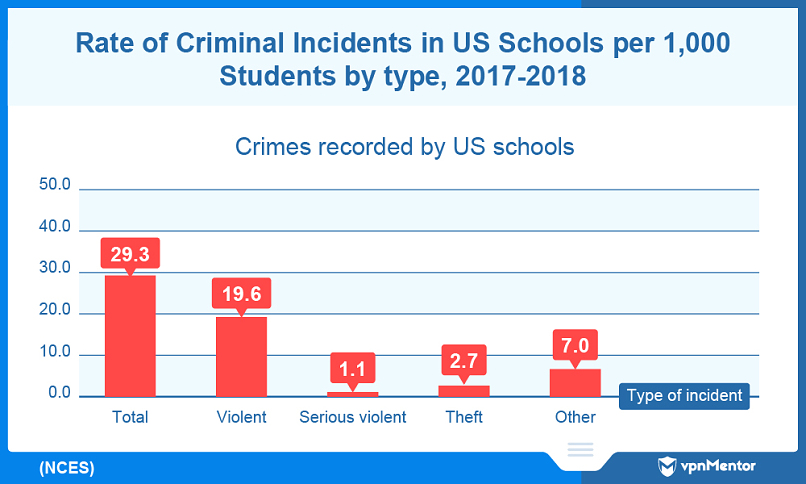
2017-18 Data from the NCES gives us a snapshot of commonly recorded crimes.
Violent crimes, such as physical fights, attacks without a weapon, and threats, are the most common category of incidents in schools. Violent crimes can occur in bullying incidents and physical altercations. There were nearly 20 violent crimes for every 1,000 US schoolchildren in 2017-18.
"Other" is the second most common category. "Other" includes possession of a firearm, weapon, or explosive device, vandalism, and the possession, use, or distribution of illicit or prescription drugs.
Theft incidents were the third most frequently recorded crime, while serious violence, such as rape and attacks with a weapon, weren't reported quite as often.
It's worth noting that some of the most damaging incidents are often not recorded.
Everyday conflicts, such as verbal assaults and bullying, seem less impactful than isolated incidents. Still, these occurrences can accumulate to cause significant torment to students.
6. How Often Do College Students Experience Crime?
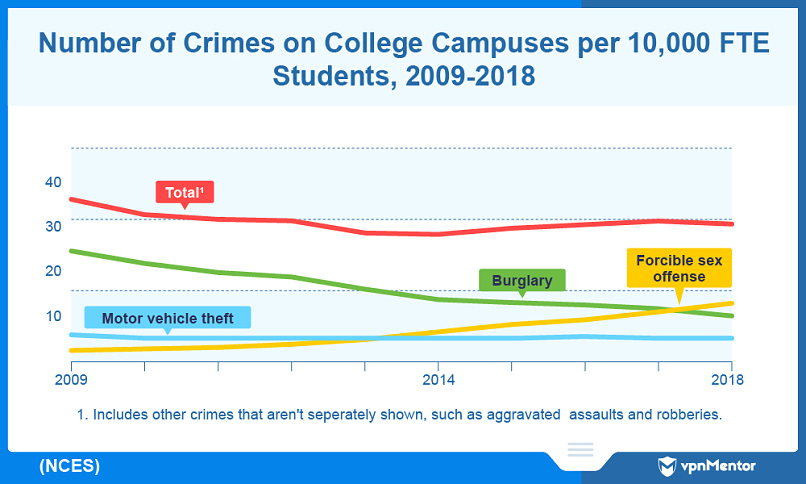
| Burglary | Unlawful entry of a structure with the intention of committing a crime or theft. |
| Motor Vehicle Theft | Attempted or successful theft of a motor vehicle. |
| Forcible Sex Offense | Any unwanted sexual act directed at another person. Includes fondling, touching, and rape. |
US colleges are required by law to collect and disseminate statistics covering crime rates on campus. This means students know in advance and realtime how much crime occurs at every university.
Some 28,500 crimes were committed on college campuses around the US in 2018. That figure represents a 16% decrease in the levels of on-campus crime compared to 2009.
7. The Most Common College Crimes
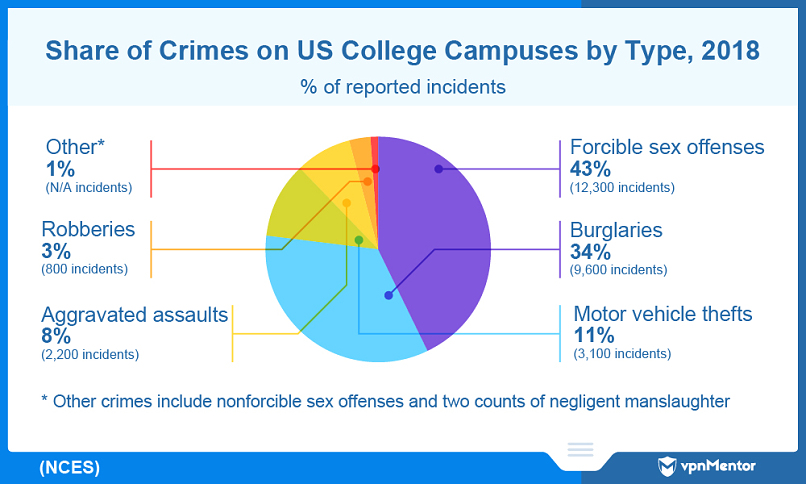
| Robbery | Taking or attempting to take something of value by way of threats or violent force. |
Some crimes are observed more than others on college campuses. Forcible sex offenses are the most common crime reported on US college campuses, with 43% of incidents falling into this category. Students are especially vulnerable to forcible sex offenses. According to the Department of Justice, female students aged 18-24 are 3 times more likely to experience sexual violence than other US women (on average).
Burglary is the second most common campus crime; 34% of incidents fall into this category. Outside of forcible sex offenses and burglary, there's a significant drop-off to the third most common college crime, car theft, accounting for 11% of incidents.
8. Which Crimes Aren’t Reported?
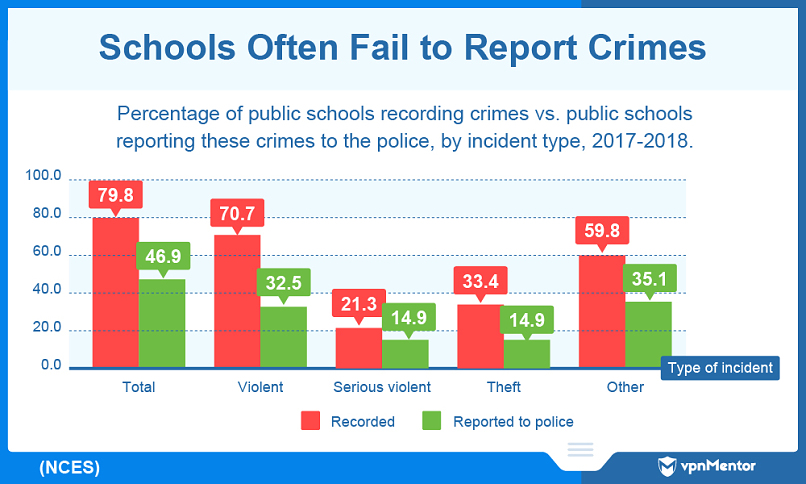
Another look at NCES data gives us a panoramic view of underreporting in US schools.
This is a big problem. Just 46.9% of schools reported crimes to the police in 2017-18, yet almost double the number of schools experienced crime. Violent crimes were among the most underreported types of crime.
But why exactly does underreporting happen in schools?
School leaders are under intense public scrutiny, particularly around issues such as school safety. Most underreporting issues occur because principals or senior staff do not want the school to be perceived as "unsafe." For many parents, inadequate safety measures are a far bigger concern than crime statistics or reported incidents.
9. Crime Has a Huge Impact on Students’ Education
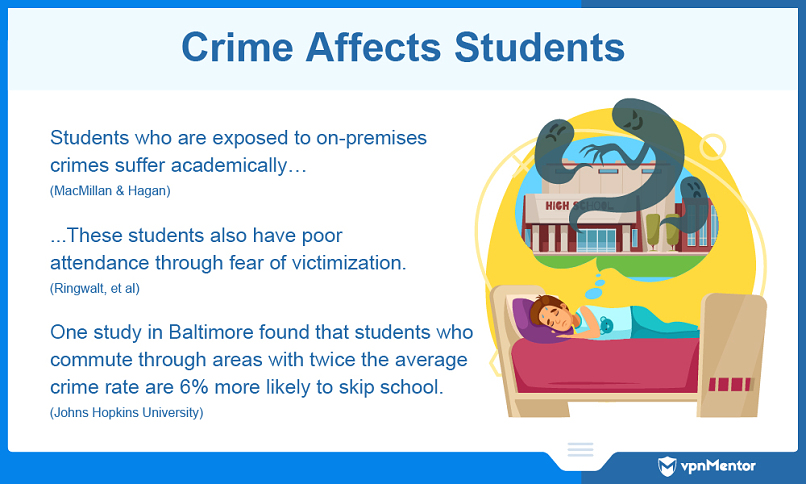
Students who suffer from on-premises crimes are more likely to see reduced academic performance and lower attendance levels. The same can be said for students commuting through high-crime areas.
This is concurrent with effects seen in school-age victims of bullying, violence, and various other school crimes (as you'll see in some of the stats below).
By reducing students' academic performance within the community, school crime effectively slows societal growth, limiting the potential of those who are affected.
Bullying in US Schools
Now we'll dive into specific facts on each type of school crime. All 50 US States have anti-bullying legislation in place. Generally, these laws define bullying and authorize school officials to step in when needed.
So, how do we define bullying? I'm sure most of us have experienced (or at least witnessed) some form of bullying in our lifetime.
Bullying includes any action that seeks to harm, intimidate, or coerce a person seen as vulnerable.
This can take different forms, such as verbal bullying (threats, name-calling, insults) and physical bullying (being pushed, attacked, or spat on). Bullying can happen in person or online.
| Bullying | Any unwanted aggressive behavior from one youth or group of youths to another person that involves an observed or perceived power imbalance. Bullying is either repeated multiple times or is likely to be repeated. |
10. Bullying Is a Global Issue
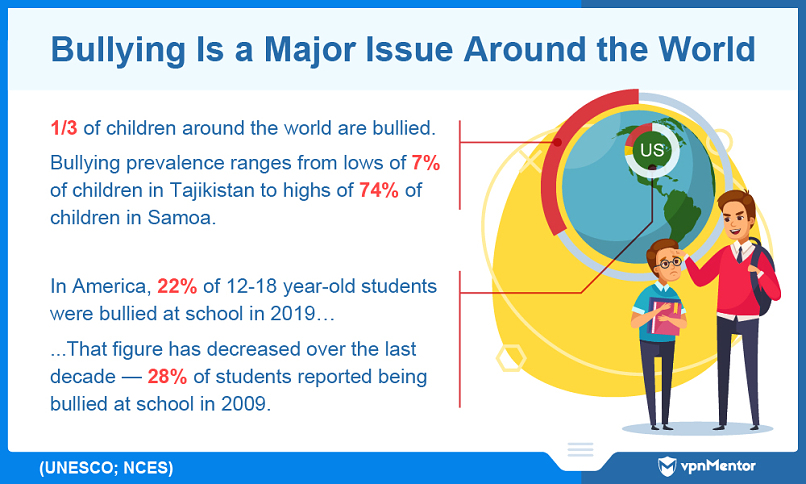
Bullying isn't just prevalent in America; it's a major issue in every school worldwide. In fact, it is, perhaps, the type of incident people commonly associate with schools more than any other.
There are movies and books about bullying, international bullying charities, and major newsworthy bullying incidents that have grabbed our attention. That's because bullying happens so regularly and to such a damaging effect.
11. What Are the Traits of a Bully?
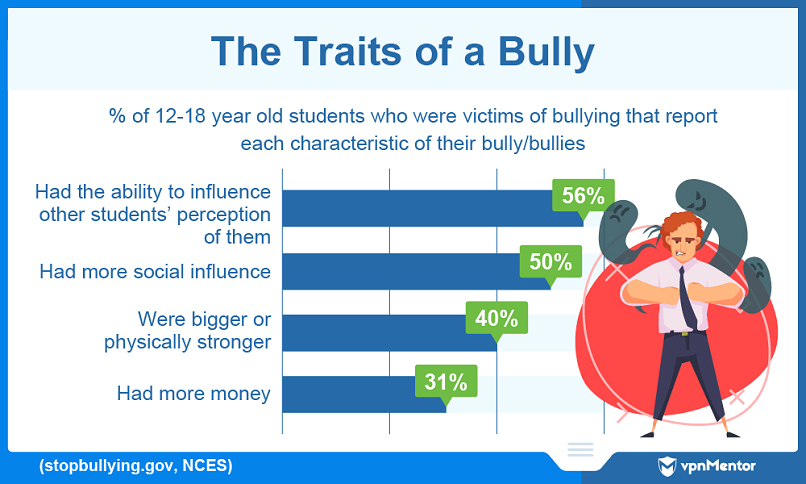
Picture the stereotypical bully in your mind's eye; according to students, this is a pretty accurate depiction.
Bullies have a physical and social advantage over the students they target. Time and again, bullies are strong and imposing. They may even have an economic advantage.
Victims of bullying cite that their bullies have a higher social standing than them. They're more popular and can influence people around them. This explains why numerous students can be involved in bullying one individual.
12. Bullying Can Be Persistent
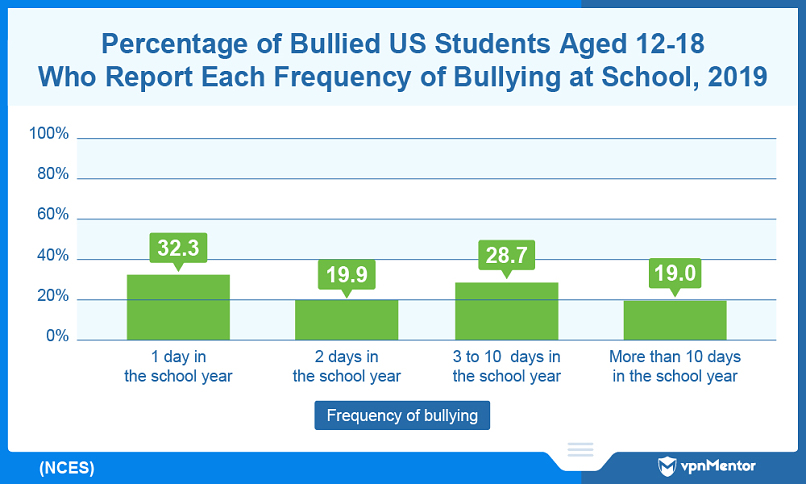
Bullying is not usually a one-off incident. Bullies can target the same vulnerable individual persistently throughout their time at school.
Perpetrators may pick on students for various reasons, leveraging their social influence or physical advantage to belittle another student. Bullies often continue to target victimized students on more than one occasion, amplifying the damaging effects of bullying.
13. Cyberbullying is a Major Issue
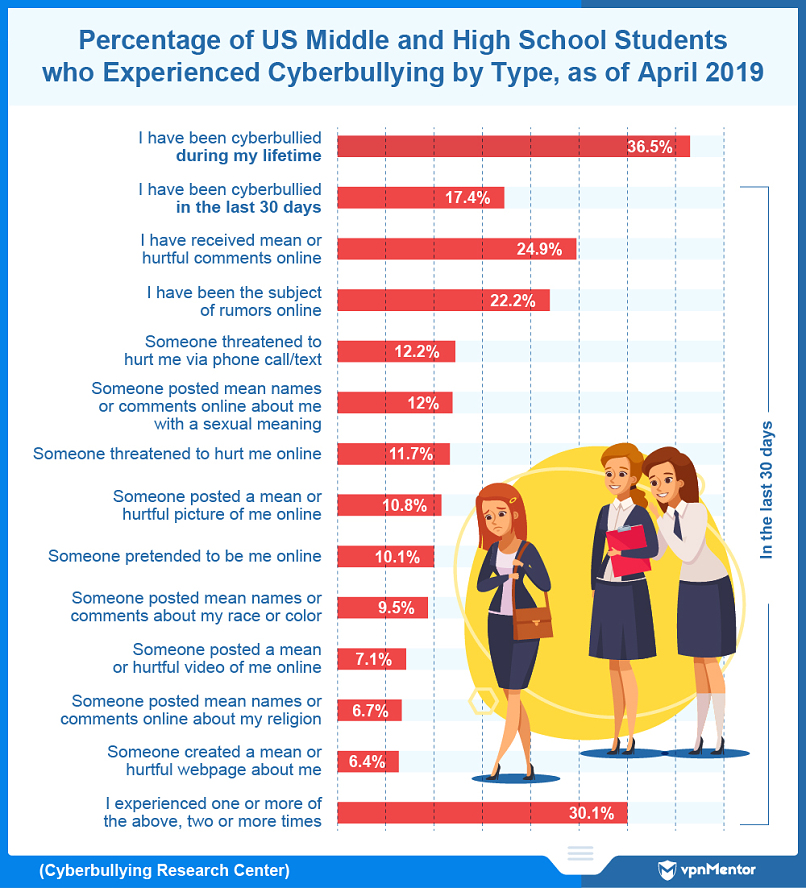
Cyberbullying is any form of bullying through online communications. It may happen through email, SMS messaging, social media, and instant messaging.
This type of bullying can be psychological torture for the victim. Cyberbullies often bombard victims with threats and insults, making the recipient feel scared and isolated while lowering their self-esteem.
14. Bullying Comes in Many Different Forms
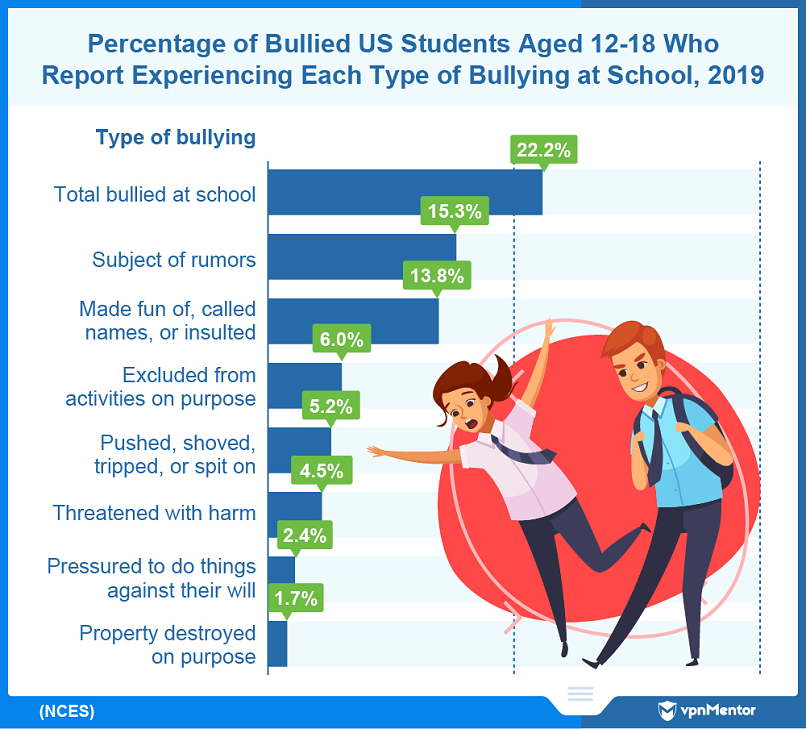
Bullying can come in many different forms. As mentioned, it can be verbal, physical, or even psychological.
False rumors are the most common form of bullying experienced by US students. Insults and name-calling are, unsurprisingly, another leading tactic.
Students can be pushed, spat on, coerced, or threatened by bullies. In some cases, a bully might break a student's possessions.
Bullying can be psychological rather than physical, too. Students who are purposefully left out of activities can feel lonely and excluded.
The NCES report also highlights that male students experience physical bullying more often than females (6% of boys vs. 4% of girls), while females experience false rumors (18% of girls vs. 9% of boys) and being excluded from activities (7% of girls vs. 4% of boys) more often than their male counterparts.
15. Characteristics of Bullied Students and Their Schools
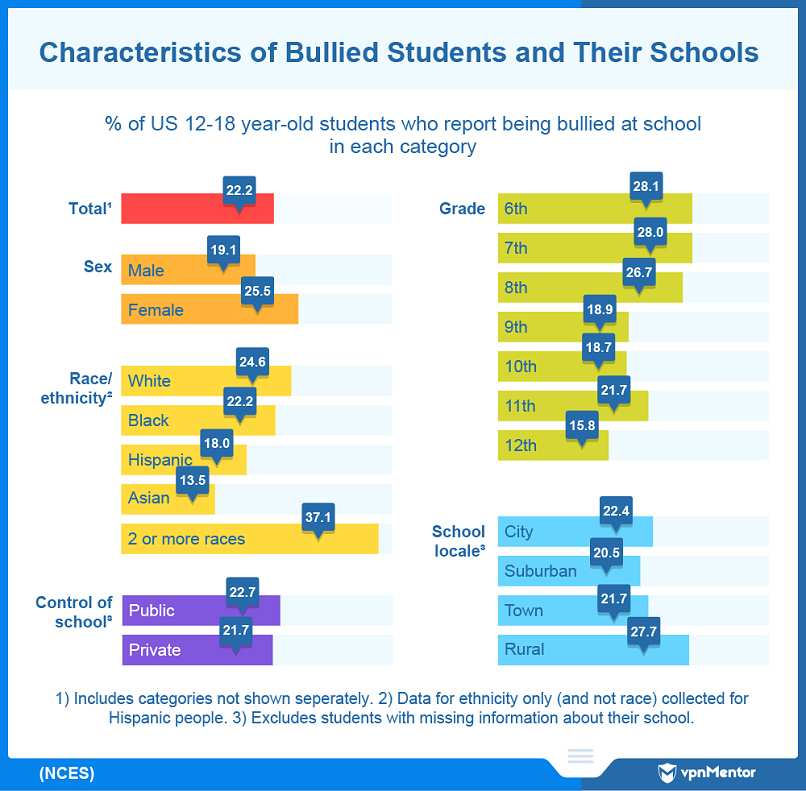
What factors influence bullying rates throughout the US?
NCES data found that girls are bullied slightly more often than boys. Race seems to be a factor, with mixed-race students targeted by bullies at a higher rate than students of other racial backgrounds.
Bullying is more frequent in the lower year groups and at rural schools. There is no real difference in bullying rates between public and private schools in the US.
16. Is School Bullying Sexist?
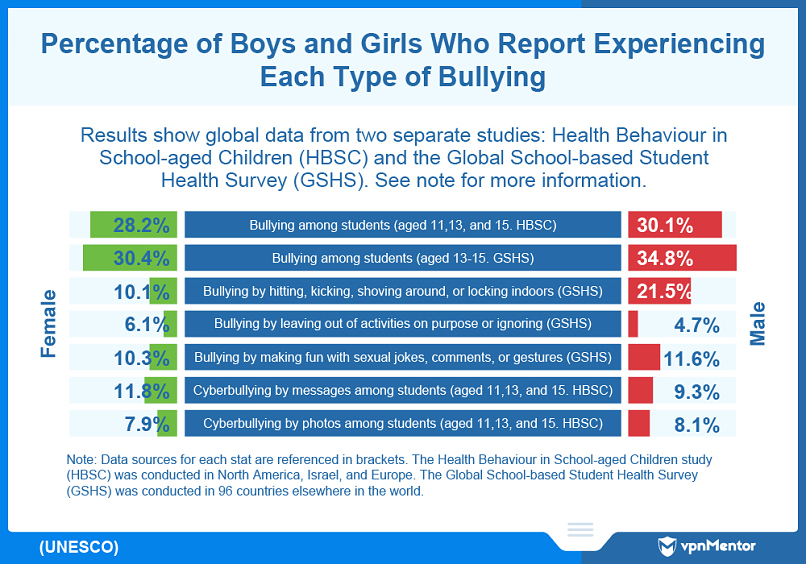
Despite the findings in the NECS report, statistics on bullying and cyberbullying throughout America and the rest of the world suggest that boys and girls are generally not singled out because of their sex. However, violence disproportionately affects boys.
Boys are bullied more than girls in some regions, such as the Middle East, North Africa, and the Pacific. Girls are bullied more than boys in 23 countries throughout Europe and North America. Overall, girls and boys are bullied at a similar rate across the world.
Data from North America and Europe show that girls are more likely to be cyberbullied via online messages, but only by a tiny margin. Global data also shows that boys are more likely to be physically bullied than girls.
17. Homophobic Attitudes Can Drive Bullying
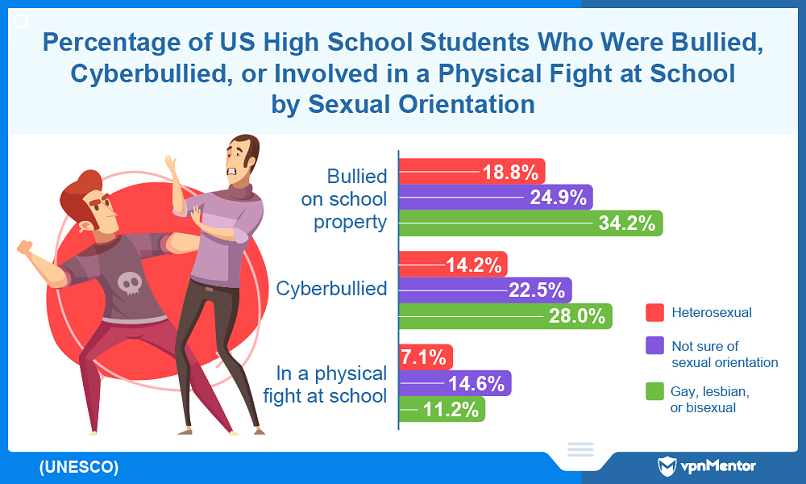
While global data does not show any impact of the student's sexual orientation on bullying, stats demonstrate that gay, lesbian, and bisexual students are targeted more often.
In the study, 11.2% of students in the United States identified as gay, lesbian, bisexual, or said they were unsure about their sexual orientation. These students had roughly twice the chance of being bullied, cyberbullied, or involved in a physical fight at school compared to heterosexual students.
This difference is even more pronounced in other nations. For example, in New Zealand, lesbian, gay, and bisexual students are 3 times more likely to experience bullying. Transgender students are 5 times more likely to be bullied.
18. Bullies Target Students for Their Identity
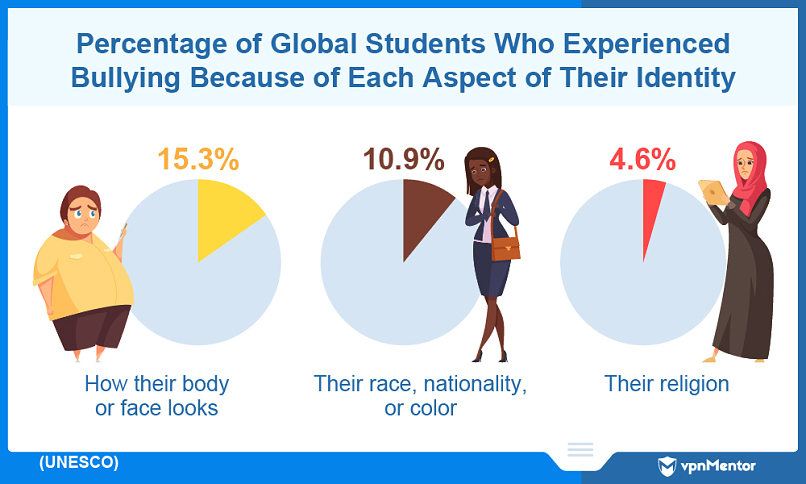
Physical appearance, race, and religion are 3 other key motivators for school bullies. Bullies will generally pick on students who look different from themselves and other students in the school.
Students are often bullied because of the way their body or face looks. The victim may be disabled, disfigured, or regarded as different in some other way by the bully.
Physical appearance is the number one reason students are bullied globally. One-third of North American students are bullied based on their physical appearance (World Health Organization).
Students may also be bullied because of their race, nationality, or skin color. This is the second most common motivation for bullying, cited by 10.9% of students.
Religion is another frequent motivator for bullies. 4.6% of victims are targeted because of their religious affiliations.
19. How Social Status Relates to Bullying
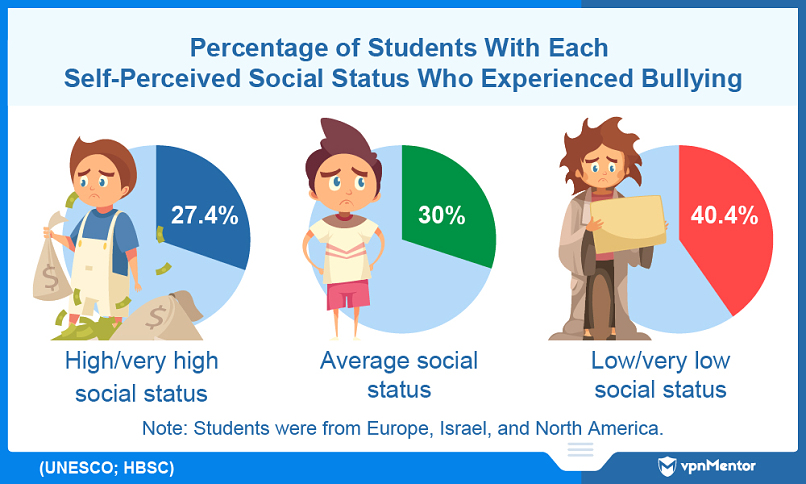
Data taken from North America and Europe show that social status is a big factor in bullying incidents.
Social status outlines a person's position in society based on numerous predetermined and achieved factors, including sex, age, race, family, occupation, and life achievements. Students with high or very high social statuses (i.e., students with more social standing) are bullied less often than others.
According to one study, 30% of students with average social statuses are bullied. Meanwhile, students with a low or very low social standing are bullied far more often.
This trend is concurrent almost everywhere in the world. Schools perceived to be "disadvantaged" have higher rates of bullying than more advantaged schools (PISA).
Students with lower social status are more likely to be cyberbullied than others. In 34 out of 42 nations included in the World Health Organization's HBSC data, 17.6% of students who perceive their social status as "low or very low" experience cyberbullying via online messages. That's more than students with an average social status (10.1%) and students with a high or very high social status (9.6%).
20. Some Students Are Bullied for Their Immigration Status
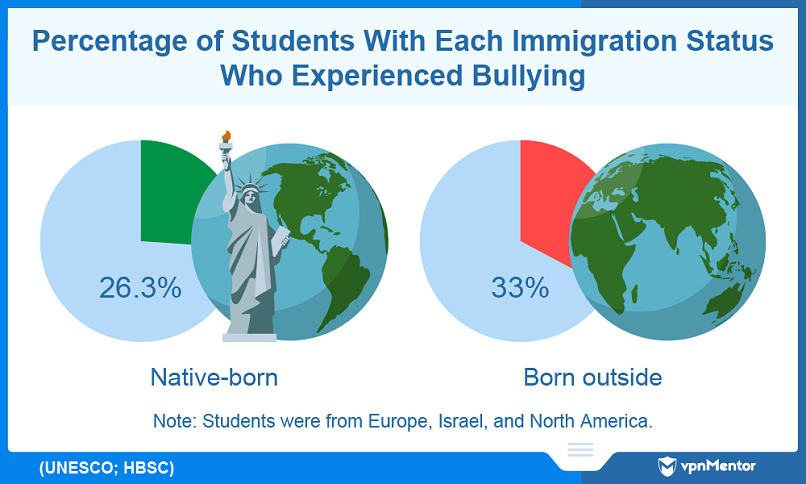
Students are targeted with bullying and violence because of their immigrant status, particularly throughout North America and Europe.
33% of immigrant students are bullied as opposed to 26.3% of native-born students. The same trend is visible in cyberbullying data. Immigrant students are cyberbullied via online messages 14.2% of the time compared to 9.4% of native-born peers.
21. Lack of Discipline in Schools Leads to Bullying
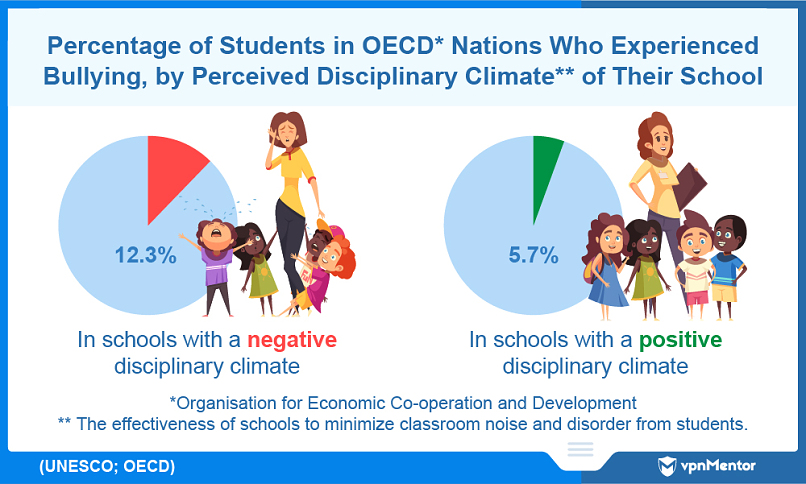
The "disciplinary climate" of a school describes its ability to minimize noise and misbehavior from students. Schools that have a better disciplinary climate have lower levels of bullying amongst students.
In other words, schools that do a better job of socializing students have fewer behavioral issues. The statistics suggest that, in the absence of proper discipline, there's a higher chance that students will bully other students.
22. Bullying Can Cause Mant Risk Behaviors in Students
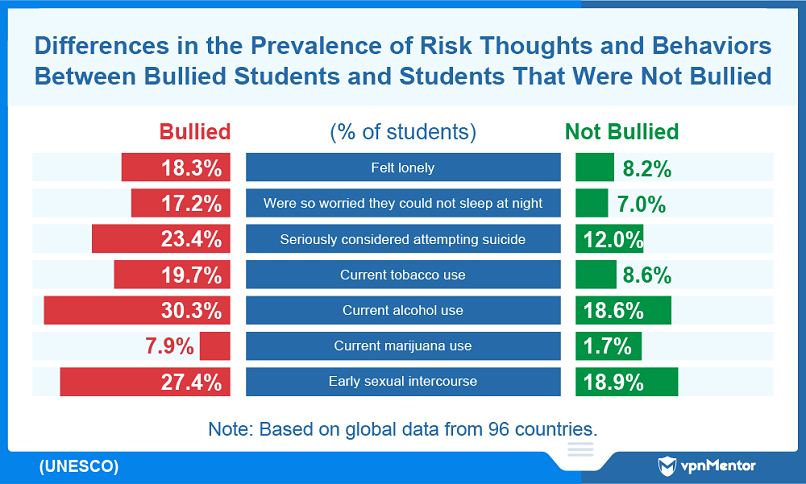
Bullying can cause significant psychological trauma and problematic behavior in students.
According to global data, bullied students are twice as likely to report feelings of loneliness, an inability to sleep, or suicidal thoughts compared to others. Another study of UK students found that depression, social anxiety, and suicidal thoughts are the top 3 psychological effects of bullying.
Bullied students may lose self-esteem, which can lead to substance abuse and self-harm. One study found that in member states of the Organization for Economic Co-operation and Development (OECD), over one-quarter of student victims of frequent bullying report a low level of life satisfaction.
23. 87% of School Shooters in The US Have Been Bullied
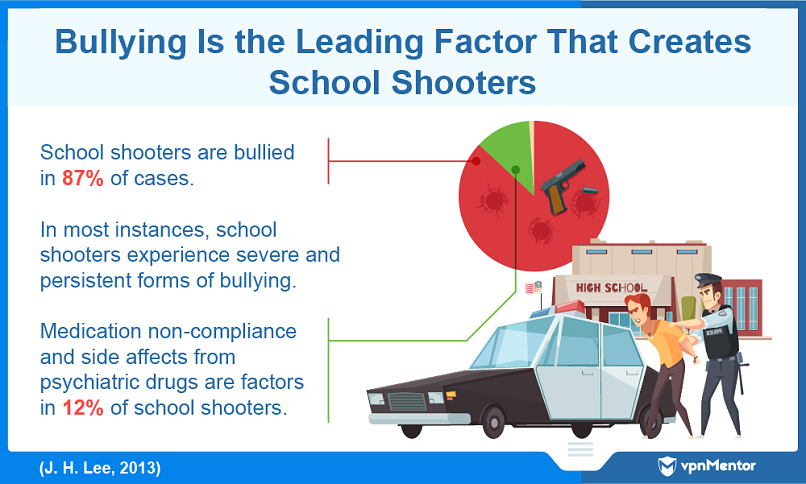
School shooters have often experienced frequent and extremely severe forms of bullying. In fact, this is the number one factor shooters cite as an explanation for doing the unthinkable.
87% of school shooters underwent bullying before the shooting. In many cases, shooters experienced extreme bullying over an extended period.
That doesn't excuse the horrific nature of their crimes. Still, it shows that bullying can cause enough mental torment to push people to the edge.
24. Bullies and Victims Can Adopt Problematic Behaviors
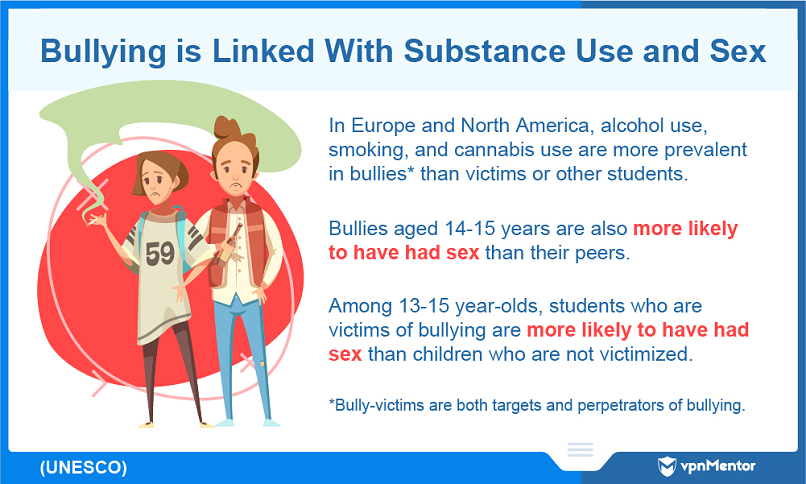
Bullies are more likely to use substances such as alcohol and cannabis. The same can be said for bully-victims — those who are both victims and perpetrators of bullying. Bullies and the people they abuse are also more likely to have had sexual intercourse at an earlier age than other children.
25. Offenders & Victims Both Lack Support
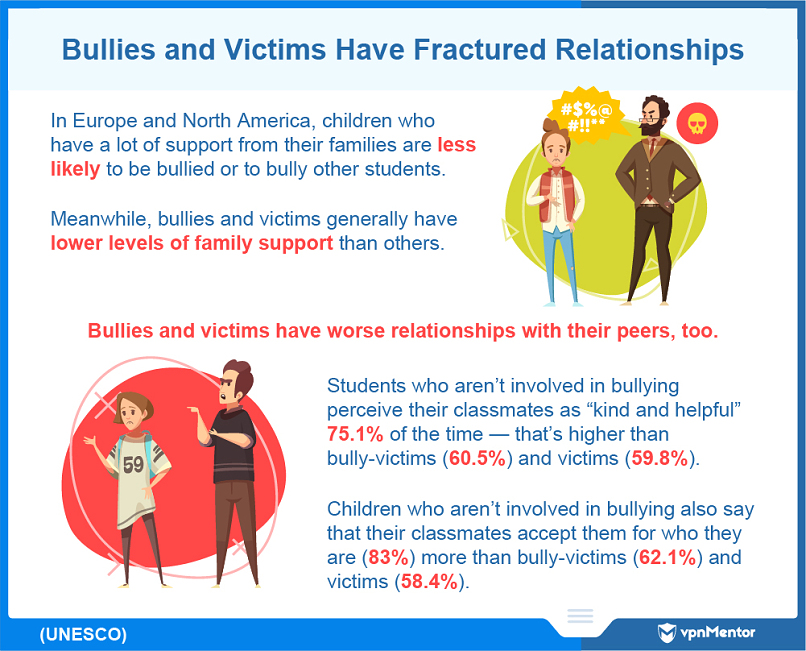
Bullying data shows that victims and offenders share a common trait: they lack support systems. Victims are less likely to perceive their classmates as "kind and helpful," and students who don't receive proper support from their families are more likely to become bullies or be targeted by one.
26. Bullying: Impacts on Education
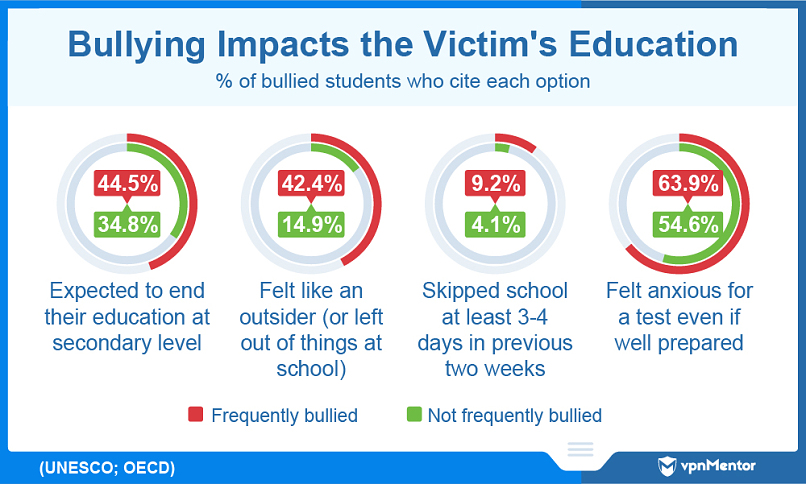
Bullying can have a massive impact on students' engagement and application in their studies.
In Organisation for Economic Co-operation and Development (OECD) nations (including America), 42% of student victims of bullying said they feel like an outsider at school. Just 15% of students who weren't bullied said the same.
Bullying begins to affect the victim's application across a range of areas. Victims of bullying skip school twice as often as others and are more likely to drop out of school at the end of secondary education. They also suffer from greater anxiety on the day of a test.
27. Bullying Damages Educational Outcomes
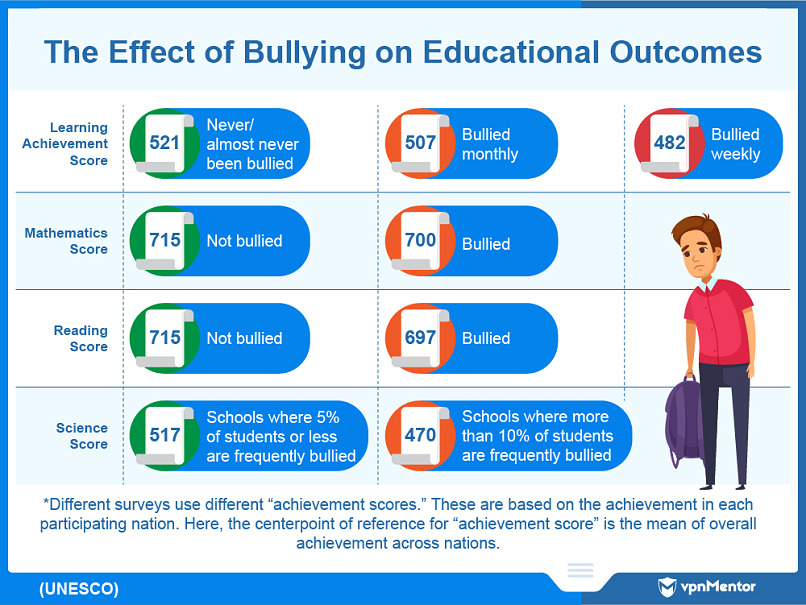
Bullying affects the learning outcomes of student victims. Data from the Progress in International Reading Literacy Study (PIRLS) shows that bullied students have lower learning achievement scores (test scores) than others. The more students are bullied, the bigger the impact on their grades.
Scores were lower across mathematics and reading tests for Latin American students who had suffered from bullying. Meanwhile, an OECD study found that bullying victims also faltered with their science scores.
28. Bullying Incidents Are Underreported
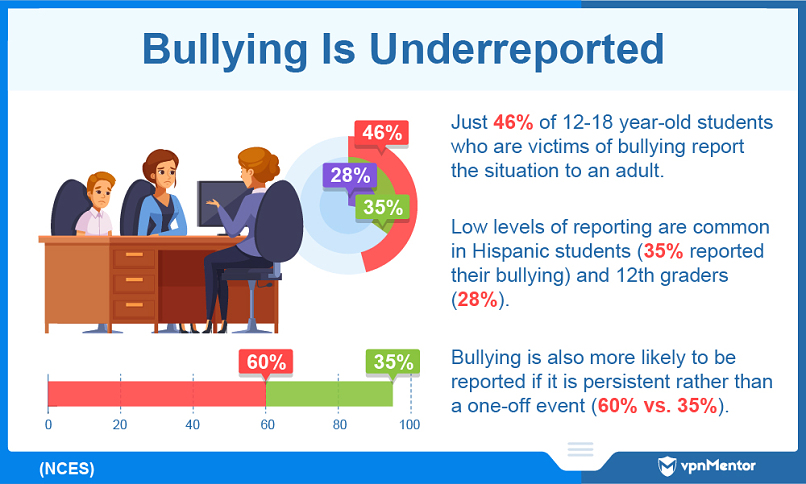
Bullying incidents typically go unreported. As we've touched on, bullying can be regarded as an "everyday" occurrence in school rather than a serious incident.
This leaves bullied students with nowhere to turn for help. The accumulation of "minor" bullying incidents causes lasting damage to victimized students who may carry consequent insecurities with them for the rest of their lives.
Violent Crimes & Theft
Some students engage in physical fights and might push, punch, kick, or rob other students at school indiscriminately.
Violent crimes, according to the US Department of Education, encompass everything from incidents of verbal threats to robberies, physical attacks, and sexual violence. Thefts are non-violent incidents of stealing.
These crimes can occur across a range of different circumstances. Perhaps a student attacks another student or steals from a teacher. A teacher may even sexually or physically assault a student.
Whatever the cause may be, let's look into the stats on violent incidents and theft in US schools.
29. The Scope of School Violence
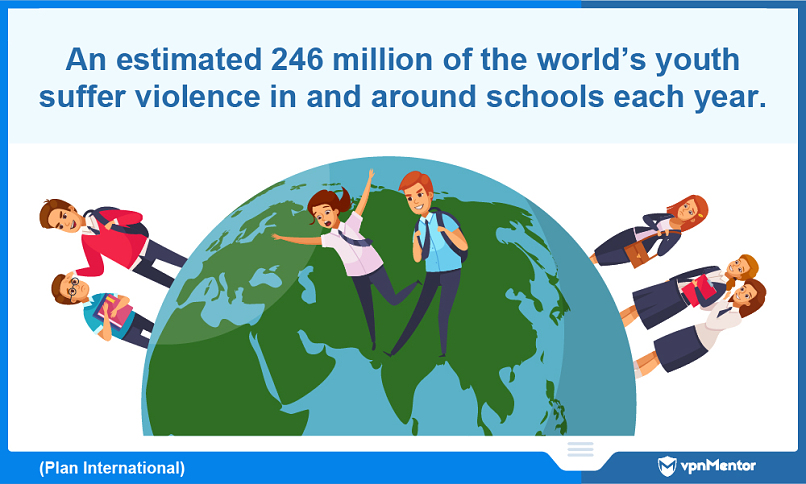
Violence in schools is not just an issue in America. Violence is a problem in basically every school across the globe.
Nearly 250 million children and adolescents suffer from violence in or around school property every year.
30. How Many Schools in The US Experience Violent Crime?
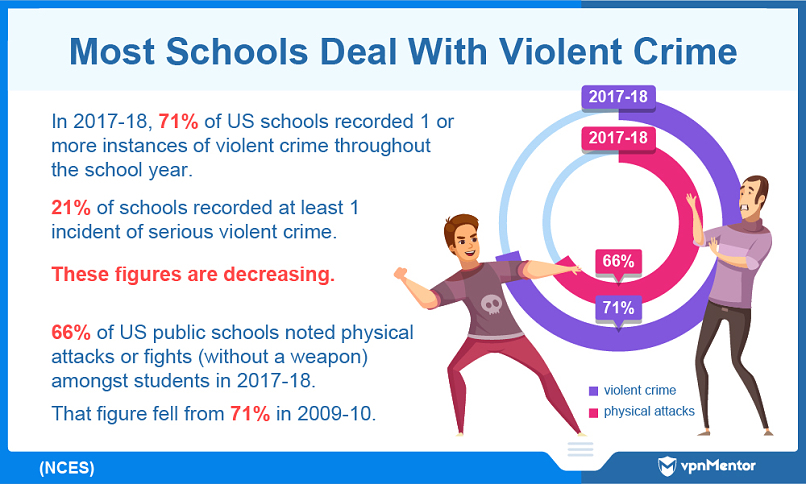
While more needs to be done worldwide to reduce school violence, statistics show that violence and serious violence in US schools are decreasing.
However, the number of schools experiencing violent incidents is still very high. Around 7 out of 10 US schools reported a violent incident in the most recent School Survey on Crime and Safety report (SSOCS). This number could be even higher if we factor in the possibility of underreporting.
Nevertheless, the downward trend evident in the data is a positive sign. It demonstrates that government-led initiatives and the efforts of anti-bullying organizations are indeed bearing fruit.
31. The Number of Violent Victimizations Is Falling
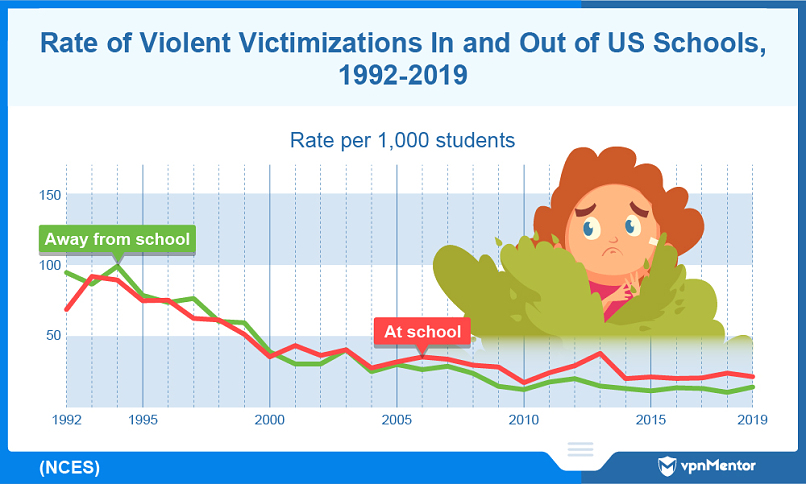
| Violent victimization | Any instance of rape, sexual assault, aggravated assault, simple assault, and robbery. |
Violent victimizations have been decreasing rapidly over the last 30 years. This emphatic downward trend is yet another indication that many forms of crime are decreasing in and around US schools.
These types of crimes fell to 21 victimizations per 1,000 students. That's nearly an 80% decrease since 1992. The statistics also demonstrate that violent victimization is more common in school than outside of school (21 victimizations/1,000 students vs. 14 victimizations/1,000 students).
32. The Number of Serious Violent Victimizations Is Dropping Too
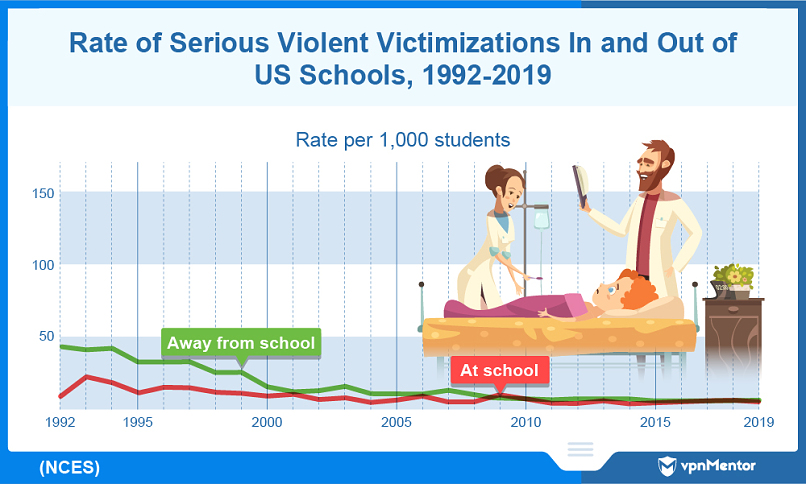
| Serious Violent Victimization | Any instance of rape, sexual assault, robbery, and aggravated assault, but not including simple assault. |
Serious victimization includes all the same crimes as the above point except for simple assault. Concurrent with violent victimizations and general crime rates, serious victimizations have seen a downward trend in prevalence over the last few years.
There were 5 victimizations per 1,000 students in 2019. That means around 0.5% of school students experience a serious violent crime.
33. Theft Victimizations Are Declining
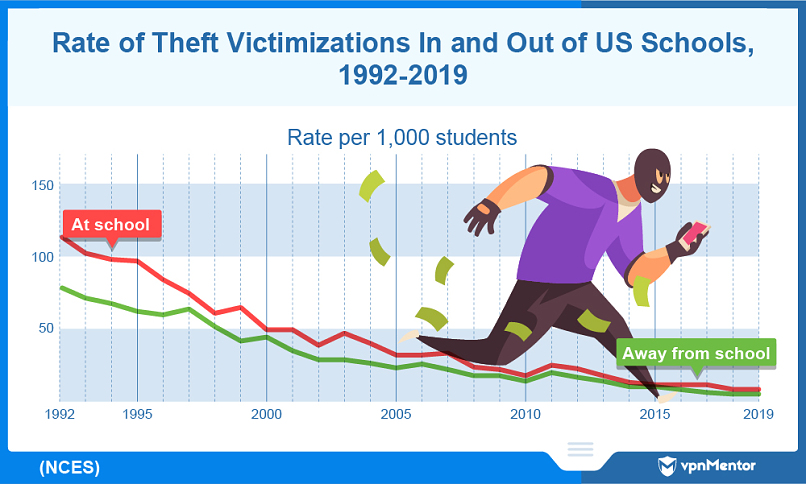
| Theft | Any instance where goods are stolen without the use of violence. |
While theft doesn't involve the use of violent force, these incidents can still be an extremely traumatic experience for students. The NCES states that incidents involve purse-snatching, pickpocketing, and any other form of theft (apart from motor vehicle theft).
Again, theft incidents have declined massively, falling to just 9 incidents in school per 1,000 students. That being said, students usually experience more theft in school than outside of school. Just 6 in every 1,000 students experience theft outside of school.
34. The Number of Physical Fights Has Fallen Slightly
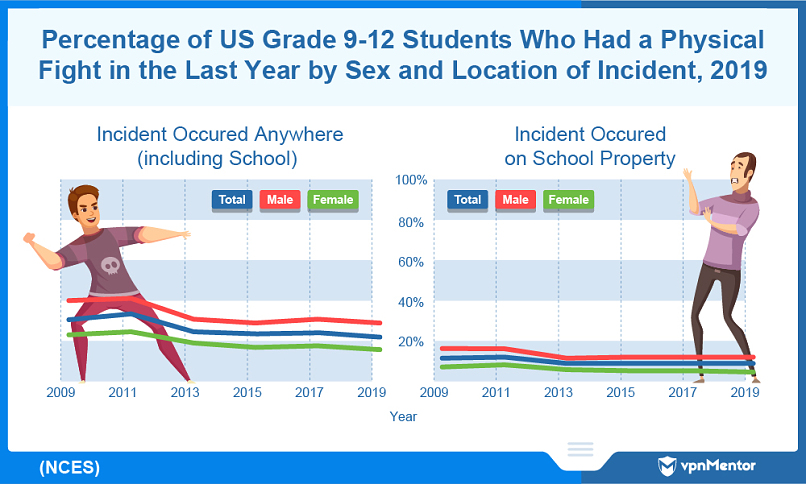
Physical fights are extremely common among students. Physical fights can occur due to altercations between two students or develop from a bullying incident. 22% of 9-12th grade students claim they were involved in a physical fight in 2019. That figure has fallen from 31% in 2009.
When asked about incidents on school property, 8% of US students said they fought on school grounds. That's a 3% drop in prevalence since 2009.
35. Factors That Influence Violence and Theft
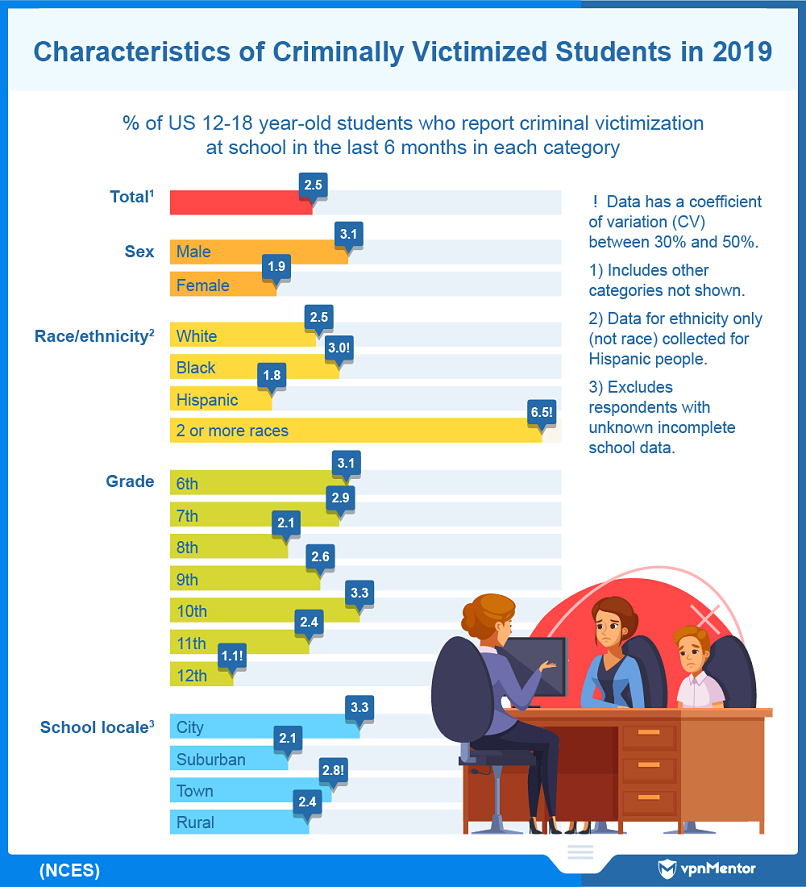
| Criminal Victimization | Any instance of theft or violent victimization. |
Certain characteristics can increase a students' likelihood of being targeted in a criminal victimization.
Violent students are more likely to attack or rob mixed-race students in or around school premises. This suggests that a portion of victimizations are racist attacks conducted because of the color of the victim's skin.
The data also shows that males are more likely to suffer an attack than females, which aligns with data on physical bullying. 6th, 7th, and 10th graders are more likely to be victimized.
Urban areas are hotbeds for attacks and thefts compared to the countryside. Students at schools in cities and towns report incidents at a higher rate than those in rural schools.
36. Sexual Assault Prevalence in Schools
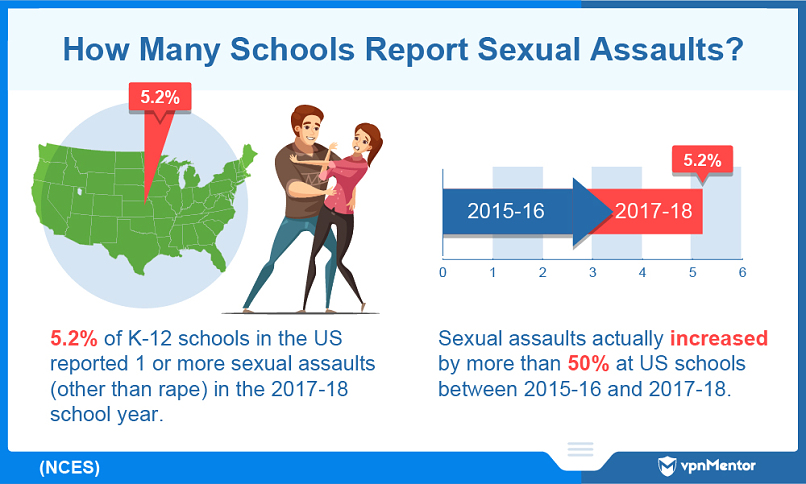
| Sexual Assault | Victimizations that usually involve unwanted sexual contact or unwanted attempts at sexual contact (apart from rape or attempted rape). Can include grabbing, fondling, and verbal threats. |
A little more than 1 in 50 US schools reports an incident of sexual assault that isn't rape. It's important to note that these crimes are typically underreported, and the actual rate of sexual assaults is likely higher.
Sexual assault is any sexual contact or behavior that was not consented to by the victim. This may include attempted rape, fondling or unwanted touching, and forced sexual acts such as oral sex. Sexual assault could occur between students, or teachers and students.
Although these incidents are included in some of the graphs above, the most recent NCES data shows that reports of sexual assaults rose significantly between the 2015-16 school year and 2017-18, increasing by over 50%.
37. Sexual Violence Mainly Affects Girls
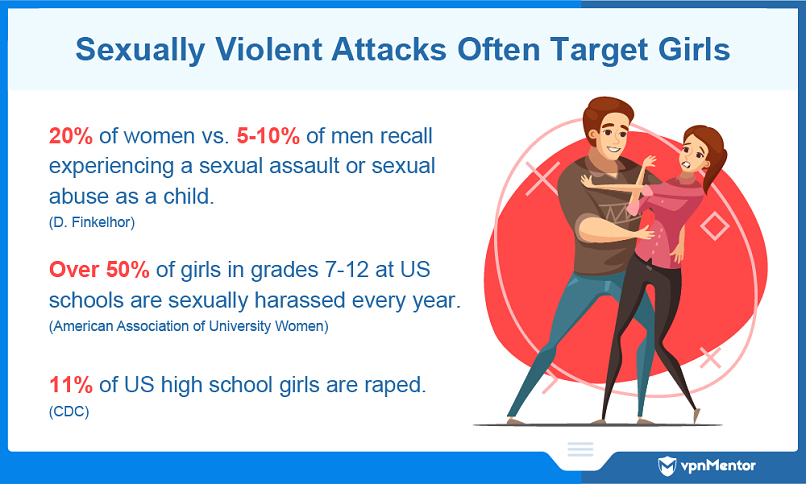
Women are targeted with sexual assaults more often than men. According to the Office of Justice Programs, 89% of sexual assault victims are women.
This issue affects female students too. More than 1 in 10 high school girls have experienced rape, and most girls between grades 7 and 12 deal with sexual harassment at least once a year. Sexual harassment is any verbal, nonverbal, or physical conduct that is sexual.
38. Sexual Misconduct from Teachers Is Common
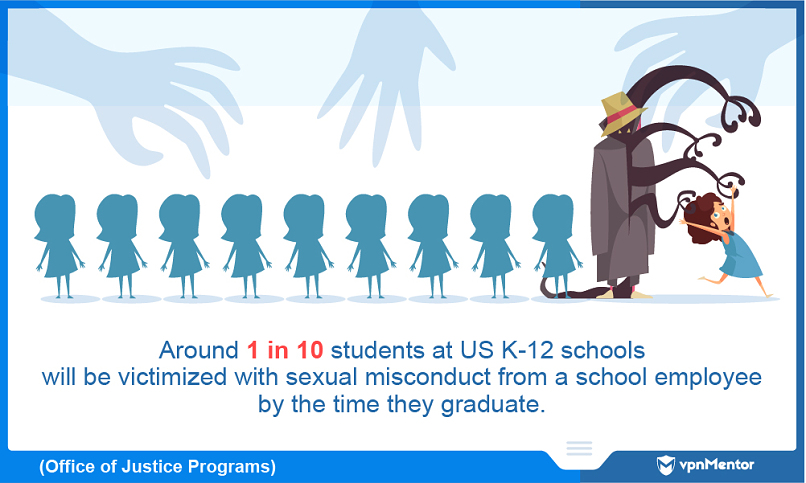
Parents trust teachers to keep their children safe. Unfortunately, teachers sometimes abuse this trust and engage in sexual misconduct towards students.
This could be forms of harassment or forcible sex offenses, such as rape and sexual assault. These crimes can significantly damage the mental health of victims.
In a study in Africa, the majority of students reported that the perpetrator of sexual violence is usually a classmate rather than an authority figure.
39. Sexual Violence in Colleges Is Common
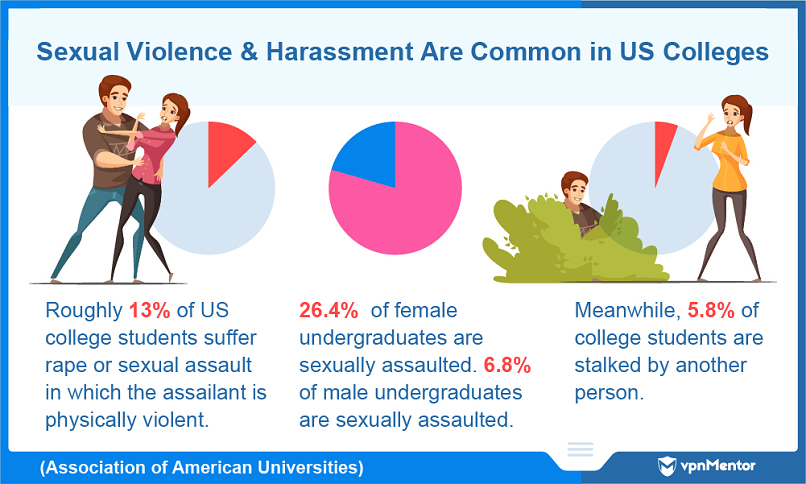
Sexual violence is a big problem at US colleges. Forcible sex offenses are among the most prevalent on-campus crimes, accounting for nearly 4 in 10 incidents in 2018.
This form of sexual violence was second only to burglaries in the NCES review. There were around 7.1 forcible sex offenses per 10,000 college students in 2018.
Statistics from the Association of American Universities (AAU) show that students have an even higher chance of experiencing all types of sexual harassment during their time at college. Around 13% of students reported being violently raped or sexually assaulted, and a further 5.8% were stalked.
40. Reasons for Not Reporting Sexual Violence
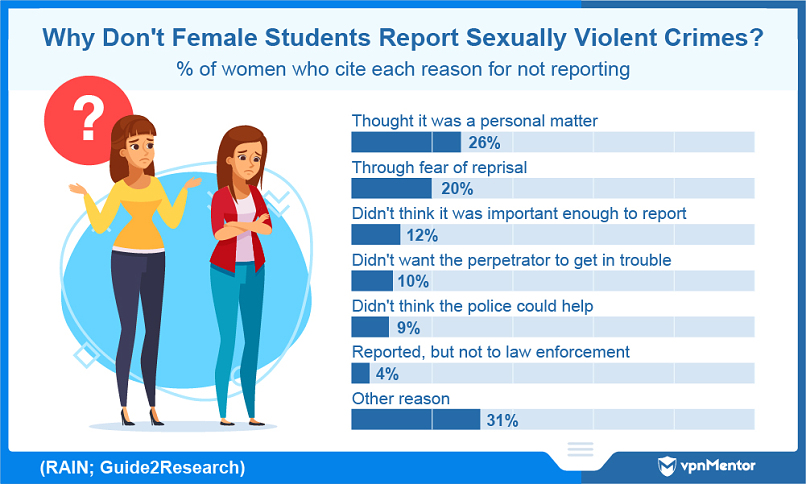
1 in 5 female students who experience sexual violence don't report the crime to the police.
Many victims don't report sexually violent crimes because they feel the incident was a personal matter or for fear of retaliation by their attacker. Sexual assault victims sometimes do not believe the incident was significant enough to report.
In some cases, victims don't want perpetrators to get into trouble, potentially because of a personal connection. Others don't trust the police to solve the issue. A small number of victims report the incident to an organization that isn't the police, such as a helpline, charity, or doctor's office.
41. How Often Do Students Threaten Each Other?
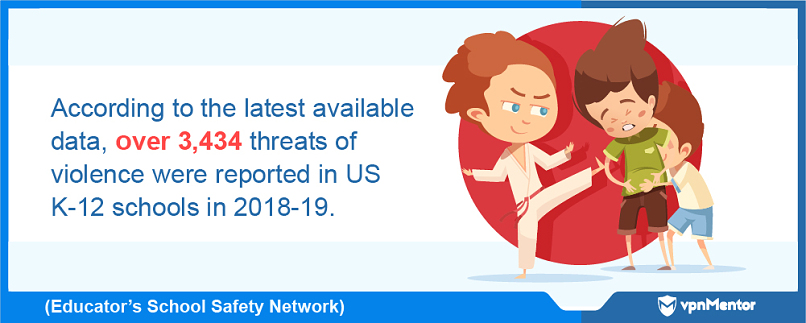
Nearly 3,500 violent threats were tracked in US K-12 institutions in the 2018-2019 school year. The vast majority of these incidents occur between students, or teachers and students.
As the following statistic suggests, the actual figure of violent threats is likely far greater, and many incidents may go unreported.
42. Students Threaten Teachers… a Lot
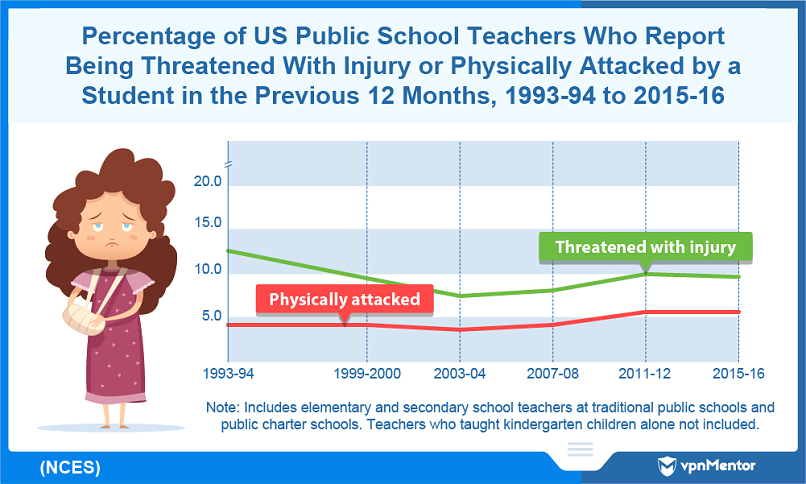
Teachers are threatened with violence from students all the time. 1 in 10 teachers in the US experienced a threat from a student in the 2015-2016 school year. 6% of teachers were ultimately attacked by a student.
Students threaten each other with physical violence as well. 6% of students reported being threatened with a weapon in 2017.
43. Biggest Types of Violent Threats
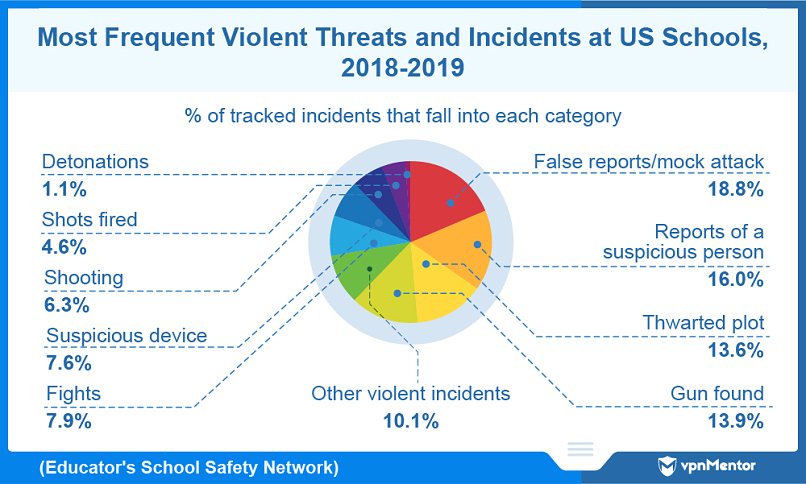
When we look at violent incidents and threats, as tracked by the Educator's School Safety Network (ESSN), we can see some interesting figures.
False reports, mock attacks, and reports of suspicious persons are some of the most common violent threats tracked in US schools. Some students use threats to leverage the fear of gun violence and cause chaos and promote a response from police. This is, in part, the reason why mock attacks are so common.
Fights are the most common violent incidents, while 6.3% of tracked incidents involved a shooting. According to the ESSN, school shooting statistics were lower than expected. However, the prevalence of weapons-related threats and incidents overall suggests this is still a serious issue.
It's also interesting that bomb threats are so commonplace, especially considering the small amount of media coverage that bomb incidents receive compared to gun violence. The Educator's School Safety Network found roughly 6 bomb threats for every 10 gun threats.
44. Who Makes Violent Threats in US Schools?
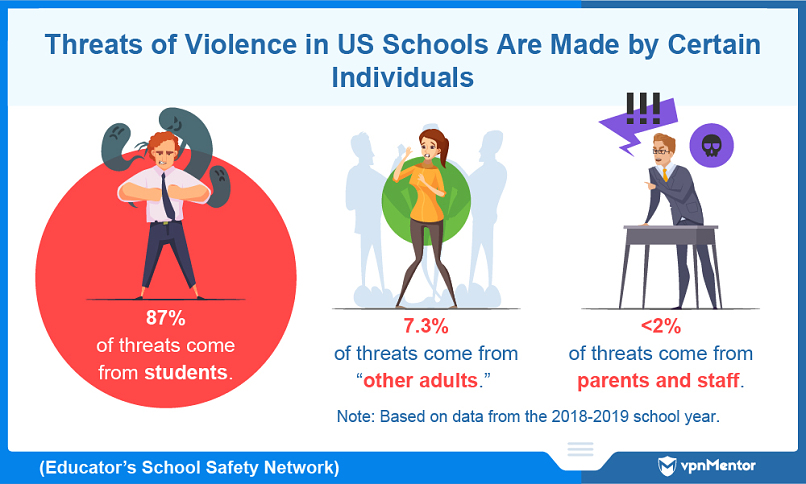
In schools, students are behind violent threats more often than not. 87% of violent threats come from students. It's far less likely for parents or school staff to threaten other people in school with violence. Just 2% of incidents can be classified in this category.
Surprisingly, a reasonable portion of threats (7.3%) come from "other adults." These can be people who have gained access to school grounds to conduct criminal activities.
45. Violence Among Boys in US Schools
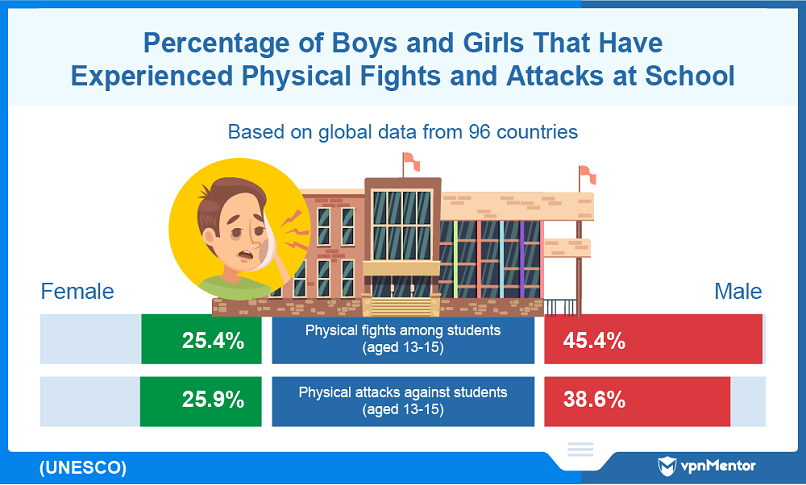
Boys are far more likely to experience physical fights or attacks in school than girls. 45.4% of surveyed boys said they had been involved in physical fights compared to 25.4% of girls. Nearly 40% of boys note that they have been physically attacked as opposed to 25.9% of girls.
Why is this, exactly?
Men are far more likely to commit violent crimes than women, and, more often than not, these crimes are targeted at other men.
A 2014 study found that around 80% of people arrested for violent crimes are men. Meanwhile, male on male violence makes up 65% of homicide cases in the US.
46. Violence Has Behavioral, Social, and Psychological Impacts
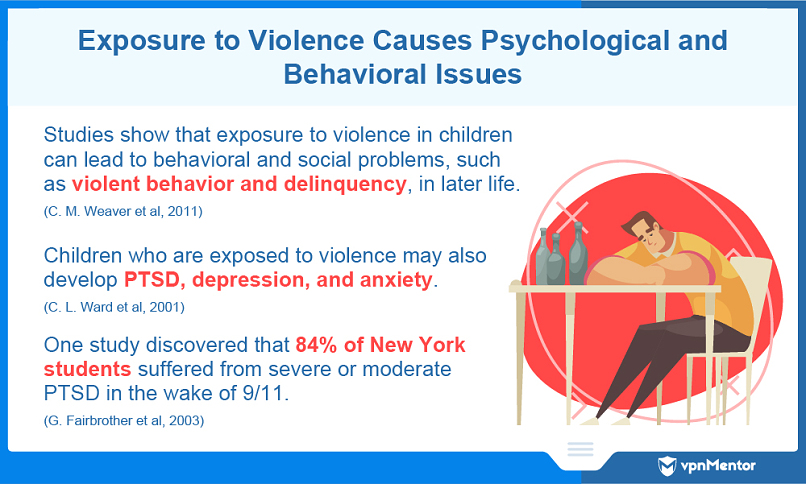
Victims of violence suffer from regressive social and mental states. Anxiety and depression, substance abuse, and even impaired behavioral functioning are all common effects of violence.
Whether experienced first-hand or witnessed, exposure to violence can bring about these effects in students.
47. Violence Affects Educational Application
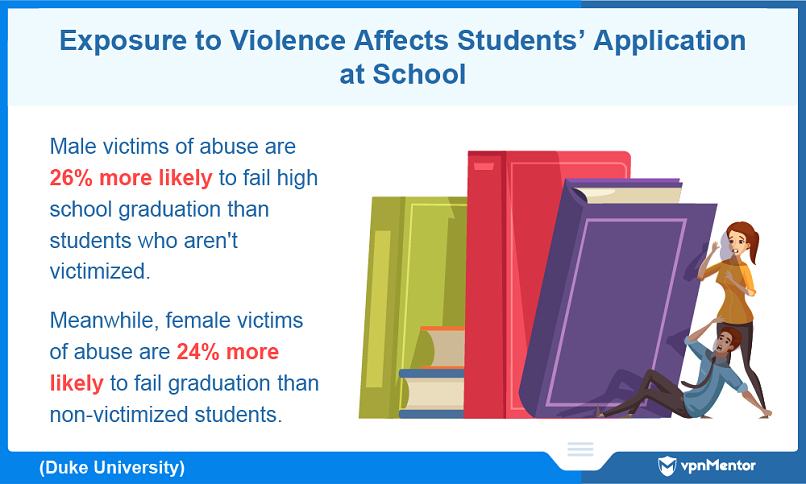
Statistics suggest that student victims of violence suffer remarkably similar impacts on their education and personal life as bullying victims.
Victims of childhood violence may completely lose focus on their studies. These students are more likely to drop out or fail to graduate. They may even exert violent behaviors later in life.
48. Exposure to Violence Damages Educational Outcomes
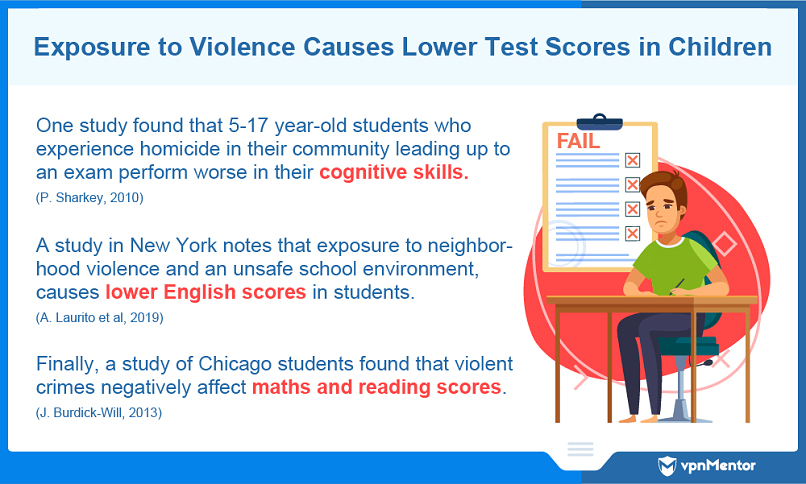
Much like victims of bullying, students who have experienced childhood violence can suffer a drop in cognitive skills.
3 separate studies have come to this very conclusion in recent years. These studies show that students don't even need to be victims of school violence to be affected. Sometimes the collective trauma experienced by communities at large is enough to cause damage.
Ultimately, the effects of violence on mental health and cognitive skills lead to impaired educational outcomes for students.
Lethal Violence & School Shootings
Violence at schools can give rise to the most extreme and saddening consequences.
Homicides, suicides, and school shootings occur dozens of times a year in US schools — many of them garnering heavy media coverage and sparking nationwide conversations about US gun laws. In some cases, suicides can occur because of bullying incidents at school. Homicides and school shootings are avoidable acts of violence facilitated by some childrens' access to firearms.
49. How Many Violent Deaths Occur at US Schools?
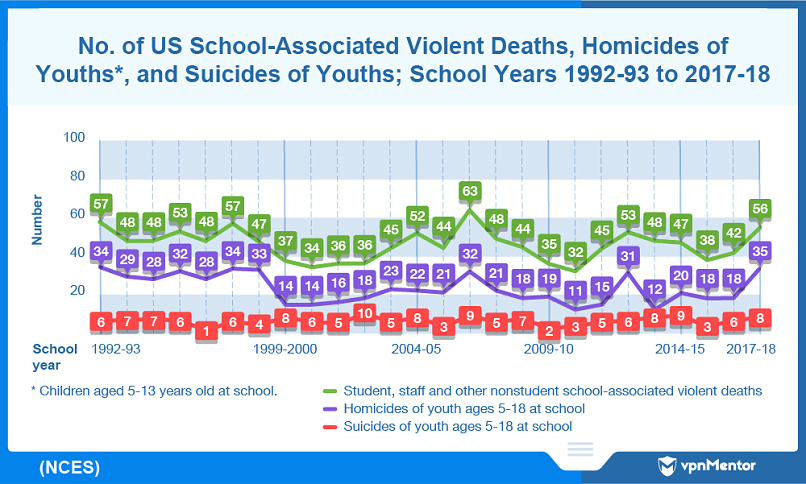
| School-Associated Violent Death | Homicides, suicides, and legal intervention deaths that occur on premises of an active US elementary or secondary school, or during the victim’s travel to or from lessons or school-sponsored events. Victims may include students, staff members, and nonstudents. |
There were 1193 school-associated deaths from the beginning of the 1992-93 school year to the end of the 2017-18 school year. There were 153 school-associated student suicides included within this total, along with 596 student homicides in the same time frame.
This data reveals a worrying trend in US schools. Although every other type of crime seems to be declining, homicides and violent incidents haven't gone away. The National Center for Education Statistics (NCES) notes that after a period of steady decline, multiple-victim homicides have been increasing in US schools since June 2009.
50. Homicides Normally Involve One Victim
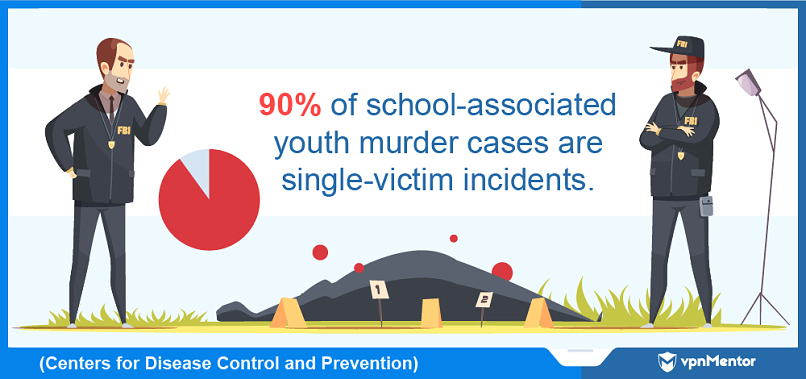
Despite increasing multiple-victim incidents, most school-related youth homicides affect a single victim.
This is contrary to popular belief. We regularly see mass school homicides on the news, so one might assume these are the most common incidents. These events get more exposure, yet single-victim incidents are far more frequent.
51. What Percentage of All Youth Homicides Occur in Schools?
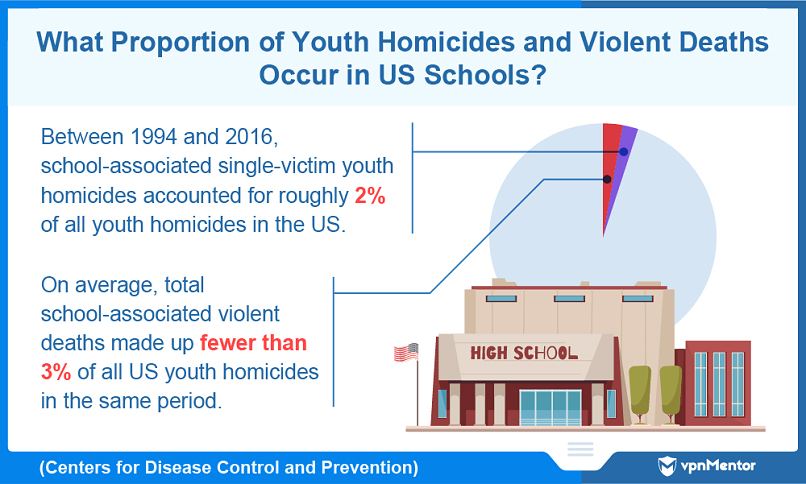
As much as we might fear for our children's safety at school, school-associated homicides account for a relatively small volume of youth homicides — especially considering the amount of time students spend at school.
Single-victim homicides in schools make up less than 2% of all youth homicides. Generally, all school-associated violent deaths account for less than 3% of youth homicides through the same period.
52. The Motivations Behind School Homicides
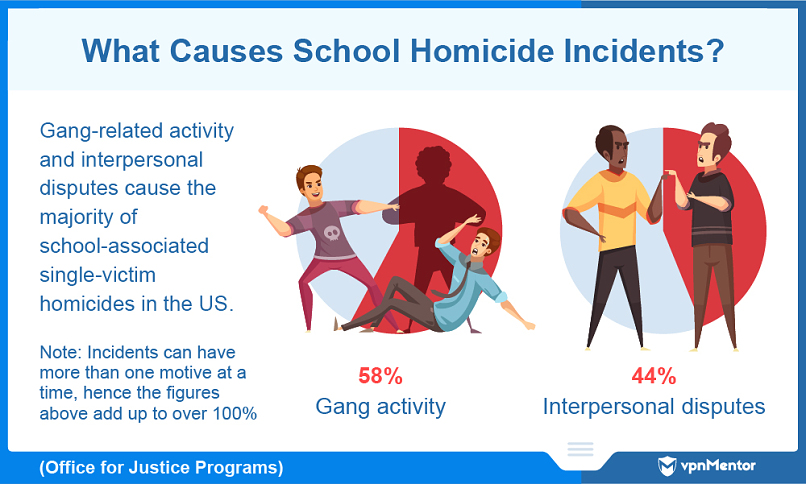
Violence in schools is often motivated by gang activities and interpersonal disputes — conditions that regularly provoke violence outside of schools, too.
Gang activities account for the majority of homicide incidents in schools. This could be due to disputes between members of different gangs that spill over into schools or because of other gang-related activities. Interpersonal disputes were the second most common cause of school-associated homicides.
53. How Many School Shootings Happen Every Year?
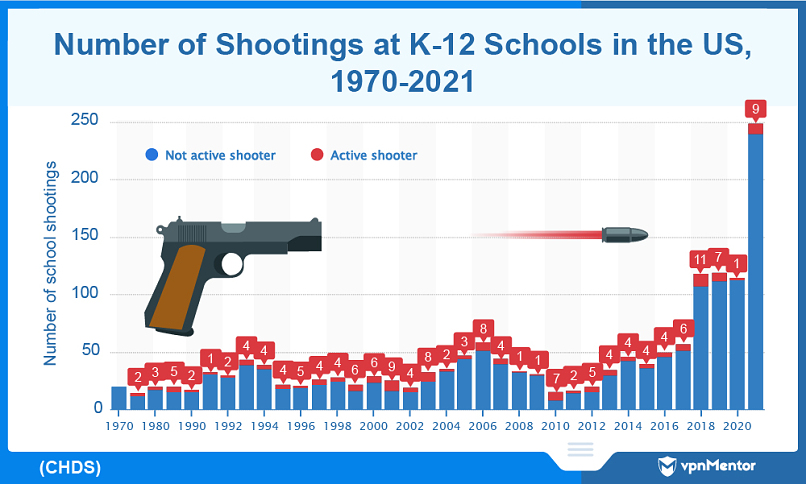
| School Shooting (CHDS Definition) | Any incident in which a firearm is brandished or fired on school property, or any incident where a bullet hits school property for any reason. |
Note: Definition is taken from the NCES glossary and applies to any data collected by the Center for Homeland Defense and Security’s (CHDS) K-12 School Shooting Database.
School-associated homicides can be the result of school shooting incidents. School shootings do not necessarily involve someone getting shot — they also include any incident in which a gun is fired at or within a school.
School shootings have occurred in record volumes over the last four years. 2021 was the worst year for US school shooting incidents on record. There were 249 total school shooting incidents throughout 2021. That's more than double 2020's total.
In an analysis of school shootings in September 2021, The Washington Post reported that an increase in incidents could be linked to recent growth in first-time gun ownership in the US. More children potentially have access to firearms than in previous years. Worse still, these weapons may not be stored securely by inexperienced gun owners.
54. School Shooting Casualties Are Rising
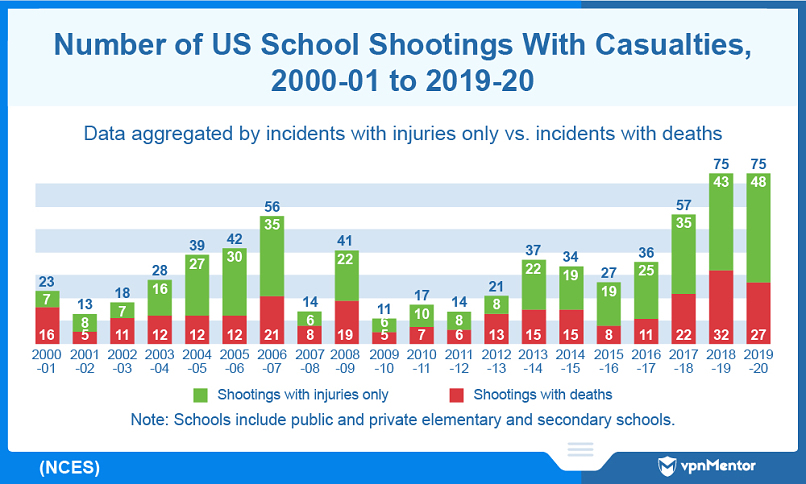
Record numbers of school shootings equate to record numbers of casualties in school shooting incidents. This is an ugly trend in US school crime.
75 shootings involved deaths and injuries in the 2018-19 and 2019-20 school years. In 2018-19, 32 incidents involved deaths, and 27 incidents involved deaths in 2019-20.
These numbers are taken from the K-12 School Shooting Database, a resource created to track a notorious segment of US school crime. The K-12 School Shooting Database provides detailed annual updates on the volume and impact of school shootings.
Since the K-12 School Shooting Database's inception in 2000-01 to its most recent report in 2019-20, 401 school shootings have been homicides. A further 277 incidents have resulted in at least one injury. That means 678 total school shootings resulted in injury or death.
55. The Biggest School Shootings in US History
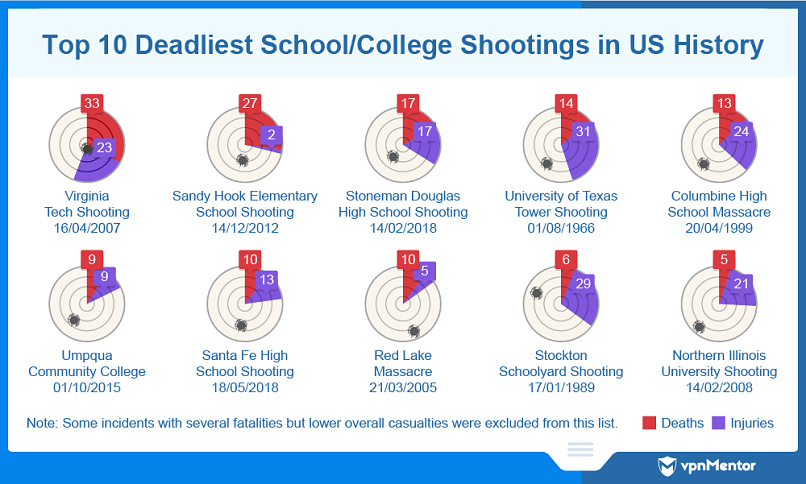
For all the wrong reasons, some of the incidents on this list linger long in the memory.
Take the 1999 Columbine massacre, a tragedy that's still traumatic for so many people. Columbine set a precedent for a modern-day school shooting in America with a level of violence rarely seen until 1999.
Sandy Hook is one of the most incomprehensibly tragic events, with many of shooter Adam Lanza's victims no older than 6 or 7 years of age.
The Virginia Tech shooting is the deadliest school shooting in modern American history. 23 year-old Seung-Hui Cho locked campus buildings to exact an indiscriminate and devastating attack.
Other noteworthy mass school shootings include:
- The Rancho Tehama reserve shooting (5 fatalities)
- The Oikos University shooting (7 fatalities)
- The Fullerton Massacre (7 fatalities)
These events had more fatalities, though fewer total casualties, than some other entries.
56. What Causes School Shootings?
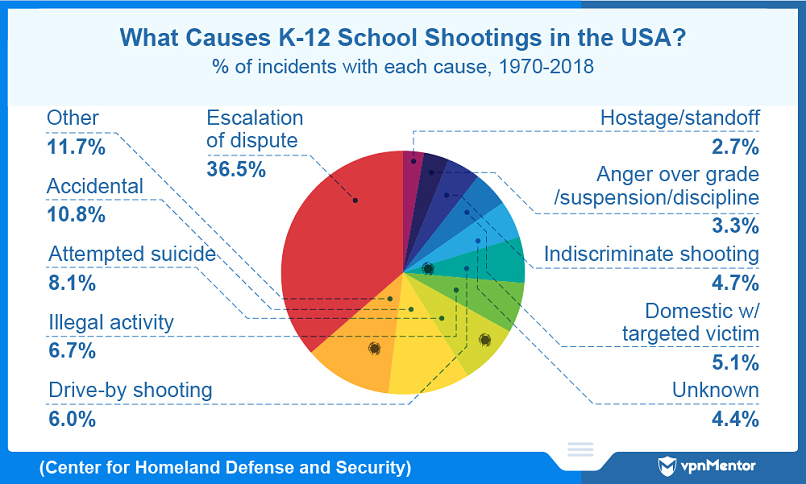
Even if we can't empathize with the appalling actions of school shooters, most people can think of factors that may trigger someone to commit such a crime. But what are the real reasons shooters turn to gun violence?
According to the Center for Homeland Defense and Security, over one-third of school shootings happen because of a dispute escalated by the attacker.
Accidents and attempted suicides make up a large portion of incidents, while drive-by shootings are a gang-related cause of school-shooting incidents.
Domestic incidents make up around 5% of school shootings. Students who are angry over their grades account for 3.3% of incidents.
57. How Old Are US School Shooters?
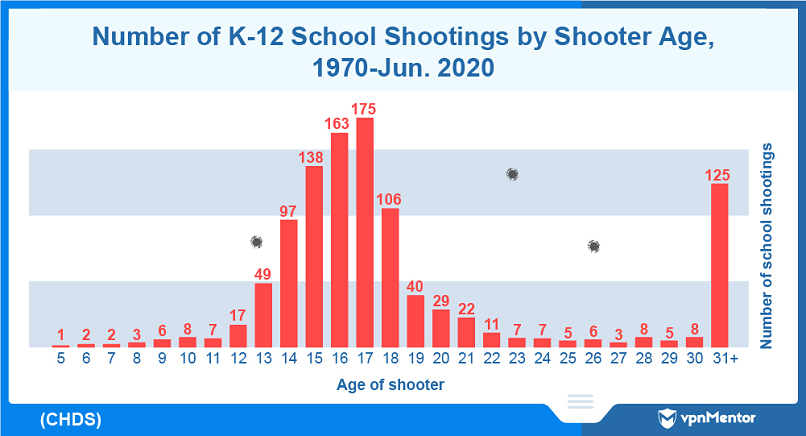
Between 1970 and mid-2020, most school shooters were 14 to 18 years old.
679 out of 1,050 total school shooters fell within this age range, according to CHDS data. Outside of the 14-18 age range, many shooters were also aged 31 or above. 125 school shooters were over the age of 31.
Many of these people could be staff members or adults who have gained access to school grounds. Around half of K-12 school shooting incidents studied by GAO were committed by parents, staff members, teachers, or persons who had no (or no known) connection with the school.
While there are school shooters who are women, most school shooters are men. In 2017, 13 active shooters at post-secondary educational institutions were male, and 2 were female. Between 2000 and 2017, every one of 37 active shooters at US elementary and secondary schools was a man.
58. Homicide Victims: Demographics
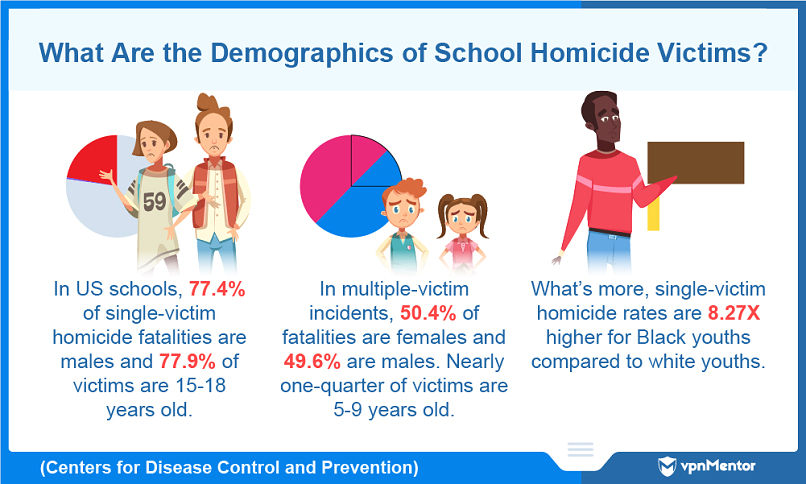
Youth homicide victims usually have a similar demographic makeup.
For a start, single homicide victims are usually male. Single victim homicides are often targeted attacks resulting from a dispute. According to several studies, men are more likely to perpetrate crimes and be victimized by violence than women. School homicide data is concurrent with these results.
Alternatively, multiple-victim homicides are usually indiscriminate attacks, such as school shootings. In this case, victims are evenly distributed between males and females.
The most frequent age bracket of single homicide victims was 15-18 years old, while multiple-victim homicides have a lower average victim age of 5-9 years old. Data also shows that Black children are victimized by homicides far more often than white children.
59. Hundreds of Thousands Are Affected by Gun Violence
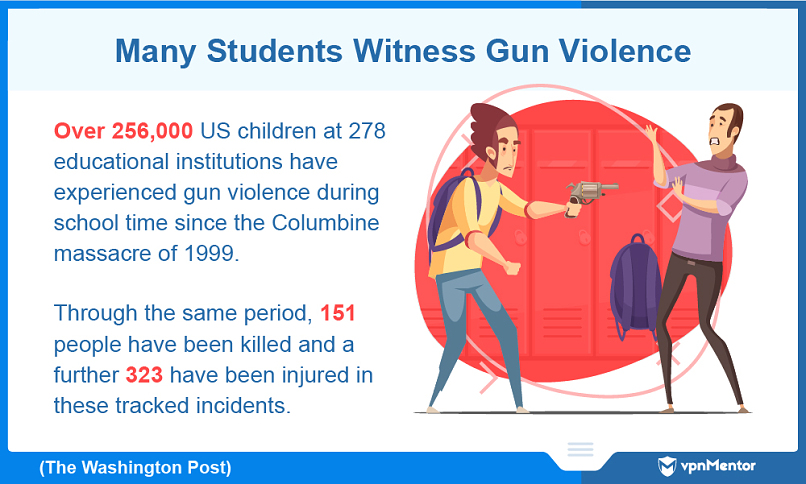
The casualties in school shooting incidents are not the only victims. Hundreds of thousands of US school children have been subject to gun violence since the Columbine massacre of 1999.
No parent wants their child to see this side of society at school. Many children faced with gun violence must deal with resulting trauma and mental health issues.
60. Communities and Students Face Long-Term Impacts
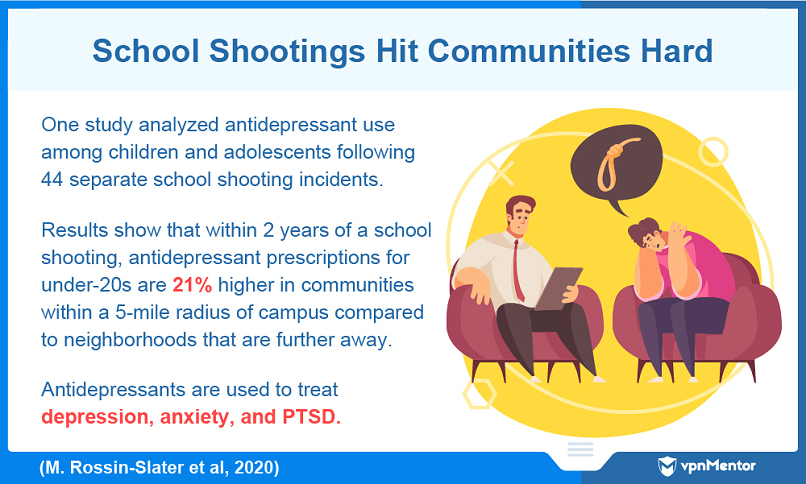
The numbers show that school shootings detrimentally affect students and the communities in which they live.
This trend could be seen following the first anniversary of the Marjory Stoneman Douglas High School Shooting in 2019. Within days of the anniversary, 2 students at the school committed suicide.
It's a stark reminder of the intense and long-standing trauma students and communities must bear after a tragic event. Sadness, fear, confusion, and anger are emotions experienced by the individuals present at the shooting, and collectively by the surrounding population.
61. School Shootings: Educational Impacts
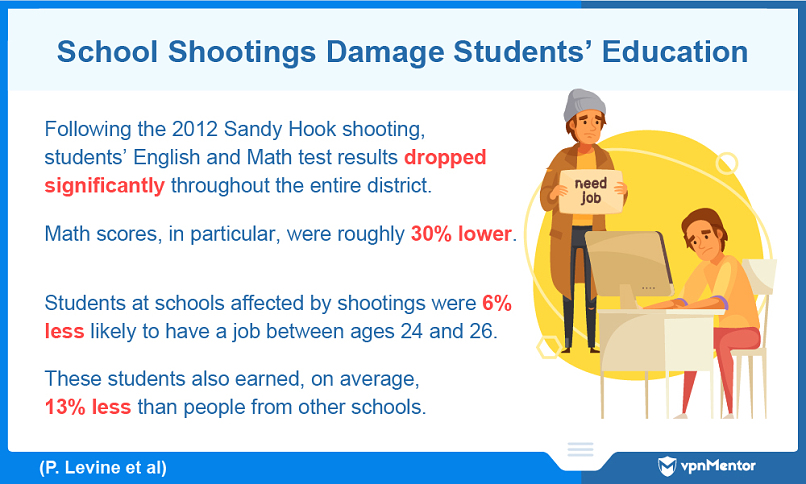
The challenges of overcoming trauma associated with school shootings lead to lower academic achievement and lower pay further down the line for surviving students.
In an article on WebMD about the psychological effects of school shootings, researcher Maya Rossin-Slater, PhD, said:
"We found that exposure to shootings at schools leads to a higher likelihood that kids are absent from school, they're more likely to repeat a grade, they're less likely to graduate from high school, they're less likely to go to college, and when they're in their mid-20s, they have lower earnings."
Hate Crimes & Racism
Hate crimes are commonplace in US schools. According to the NCES, hate crimes in US schools can be defined as follows:
| Hate Crime | Any crime that’s motivated by the perpetrator’s bias(es) against another’s race, religion, disability, sexual orientation, ethnicity, gender, or gender identity. |
Hate crimes can take the form of racism, assault, vandalism, robbery, and more. Here are the latest stats on hate crimes in US schools.
62. How Common Are Hateful Words at School?
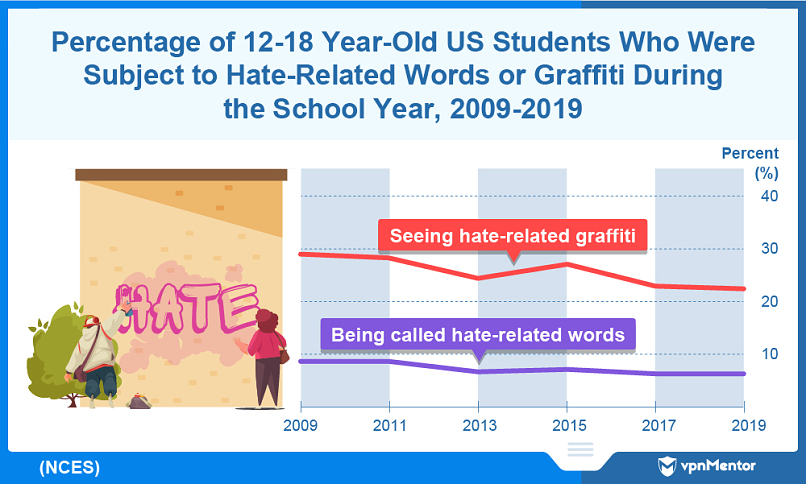
| Hate-Related Words | Refers to any language used to disparage another person’s characteristics. |
| Hate-Related Graffiti | Hate-related words or symbols written in school classrooms, bathrooms, hallways, or on the outside of school buildings. |
According to the US. Department of Justice (DOJ), roughly 7% of students aged 12-18 were called hate-related words at school in 2019. The numbers show that incidents of hate speech have been on a steady decline since 2009. In 2009, 9% of students reported experiencing hate-related words.
The same trend can be inferred from data on hate-related graffiti. 29% of students said they had seen hate-related graffiti in 2009. In 2019, that figure had lowered to around 23% of students.
63. Hate at School: Victim Characteristics
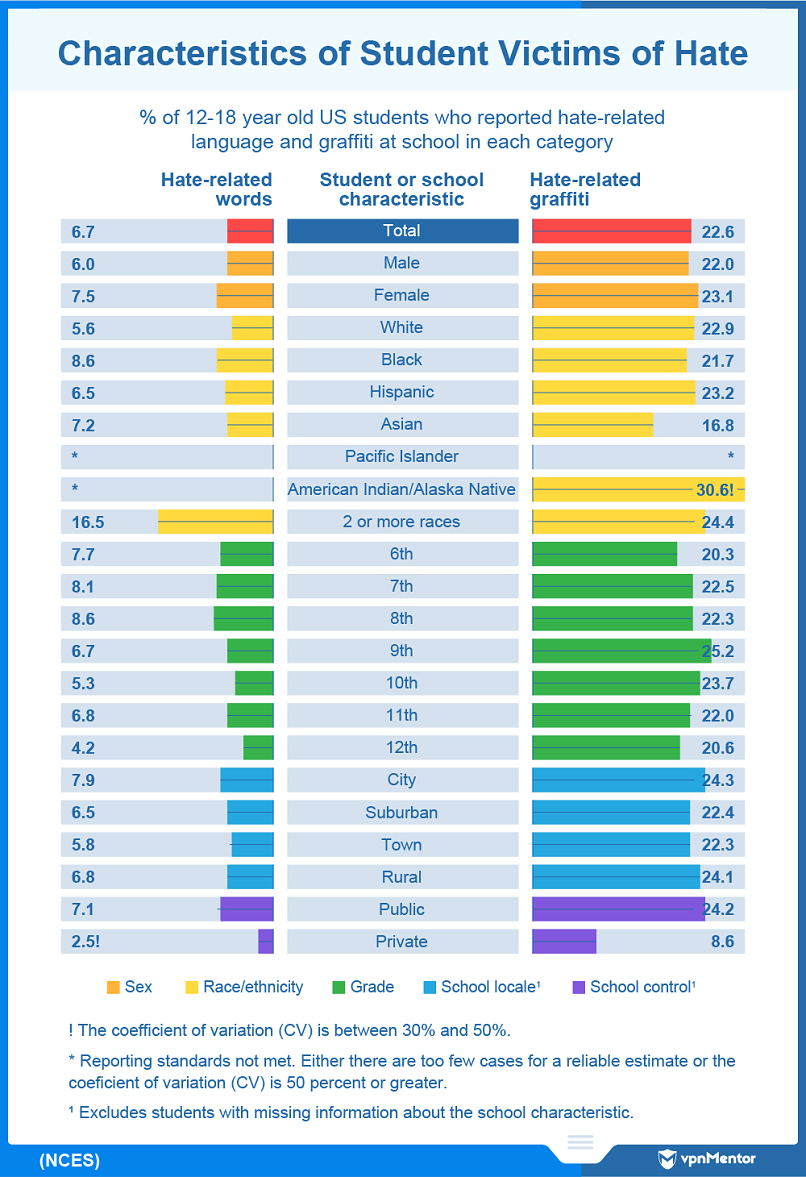
Students with certain personal characteristics are more vulnerable to hate-based language. The data shows that girls experience hateful words at a higher rate than boys. Black, Asian, and mixed-race students are targeted with hate speech more often than students of other ethnic backgrounds.
Different schools often deal with varying levels of hate speech depending on the school's type, locale, and the age of students. 8th graders, city schools, and public schools all report higher hate-related words.
Between 2009 and 2019, white students reporting hate-related words decreased from 7% to 5.6%. Hate-speech targeting Hispanic students also decreased from 11% to 6.5% between 2009 and 2019.
Women, Native American students, mixed-race students, and 9th-grade students are all more likely to experience hate-related graffiti in schools. On average, city and rural schools contain similarly high volumes of hate-related graffiti. Public schools are more likely to have this graffiti than private schools.
Experiences of hate-based graffiti decreased between 2009 and 2019 for white students (from 28% to 23%), Hispanic students (from 32% to 23%), Asian students (from 31% to 17%), and Black students (from 29% to 22%).
64. Who’s Targeted? Racist Language at School
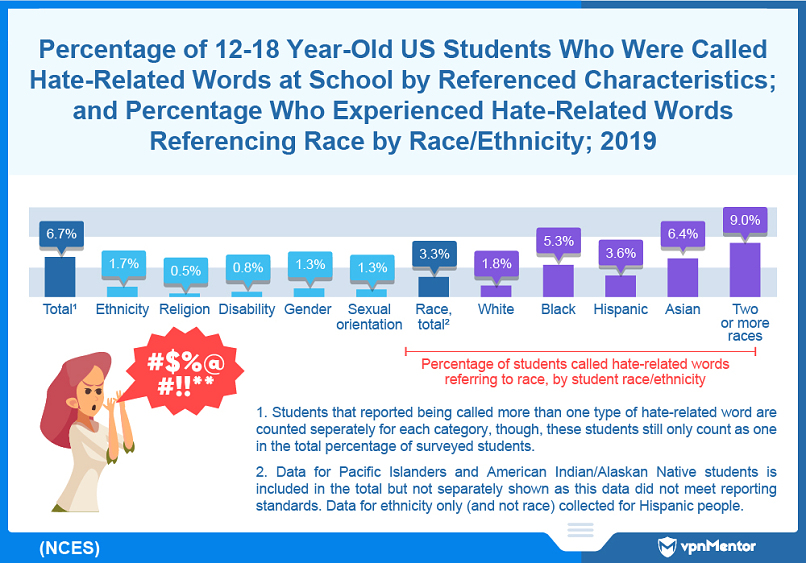
As mentioned, hate-related words include racist language.
In the DOJ's data, ethnic prejudice and racist incidents are more common among students than other hate speech incidents. 1.7% of students report hate-related language incidents that reference their ethnicity, and 3.3% of students report incidents that reference their race.
Non-white students are much more likely to be exposed to racist language. 1.8% of white students experience racial hate speech. That's compared to 5.3% of Black students, 3.6% of Hispanic students, 6.4% of Asian students, and 9% of mixed-race students.
65. Who’s Targeted? Racial Threats and Violence
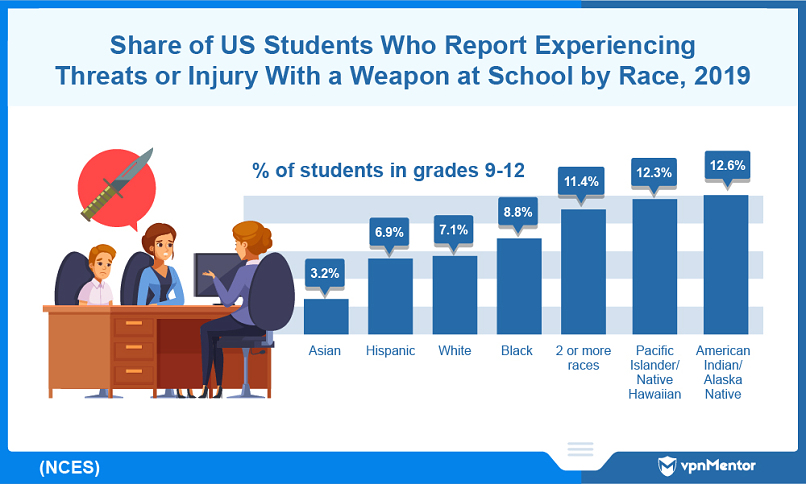
Native Americans, Pacific Islanders, and mixed-race students are more likely to experience threats and injuries from people brandishing weapons.
In 2019, Asian students were less likely to face weapon threats and injuries than students from other racial groups. However, Anti-Asian hate crimes have surged in the US since the outbreak of COVID-19, rising 339% in 2021. We need updated statistics to highlight the effect of this developing issue on US college campuses.
66. College Hate Crime Is Getting Worse
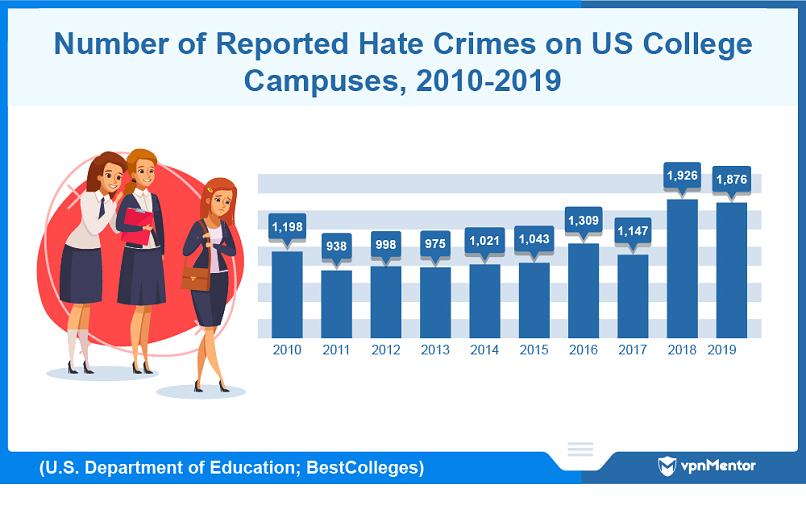
Nearly 2,000 hate crimes were committed at US colleges in 2019. That figure represents a 57% rise in the prevalence of hate crime incidents in universities over the last decade.
Colleges and schools often represent broader social trends outside of campus boundaries. The rising prevalence of campus hate crimes is indicative of a general rise in hate crime throughout the United States. According to the FBI, there were 7,759 hate crime incidents in 2020 — a 6% increase over 2019. US hate crime figures have been rising since 2014.
67. Hate Crimes On College Campuses
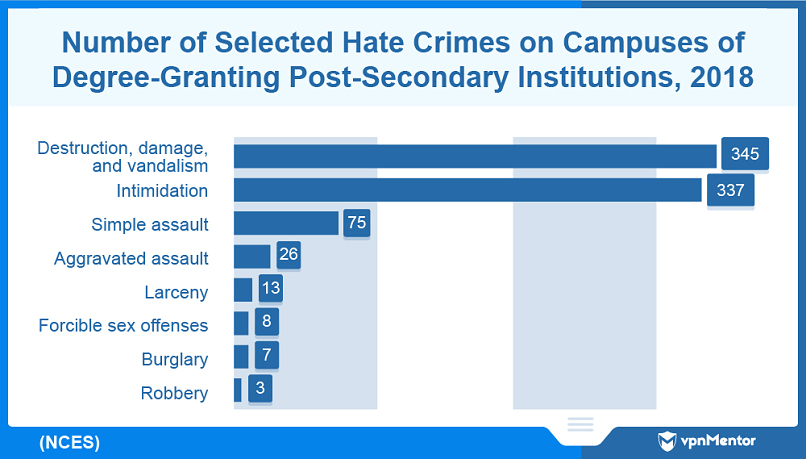
| Hate Crime (College Data) | Any crime that’s motivated by the perpetrator’s prejudice towards another’s race, color, national origin, ethnicity, gender, religion, disability, or sexual orientation. |
| Destruction, Damage, Vandalism | Any willful or malicious destroying, damaging, or defacing of another person’s property without their consent. |
| Intimidation | Incidents where someone is placed in reasonable fear of bodily harm through threatening words or conduct from another person. Does not include displaying a weapon or actual physical attacks. |
| Larceny | Unlawful taking of property. |
Note: The NCES uses two different definitions of hate crime. The above definition classifies hate crime incidents on college campuses.
Almost 350 incidents of hate-motivated vandalism occurred on college campuses in 2018. The next most common hate crime involved intimidation, which describes hate incidents where perpetrators threaten victims with their words or conduct.
Other hate-related crimes reported include assault, larceny (theft of personal property), forcible sex offenses, burglary, and robbery.
A combined 814 of these crimes occurred on college campuses in 2018.
68. Race Is the Primary Motivator for Hate Crimes on College Campuses
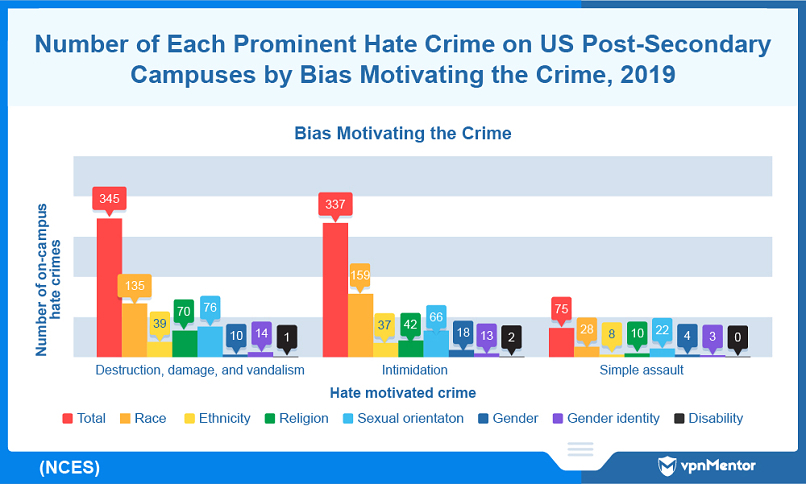
Victims of college campus crime are targeted more for their race than any other characteristic. In vandalism hate crimes, the victim's race is the motivator almost twice as often as sexual orientation (the next most frequent factor).
In intimidation hate crimes, race was the motivator nearly 2.5X as often as any other factor. For simple assaults, the difference was less pronounced, but race was still the driving factor.
69. The Effects of Hate Crime on Victims
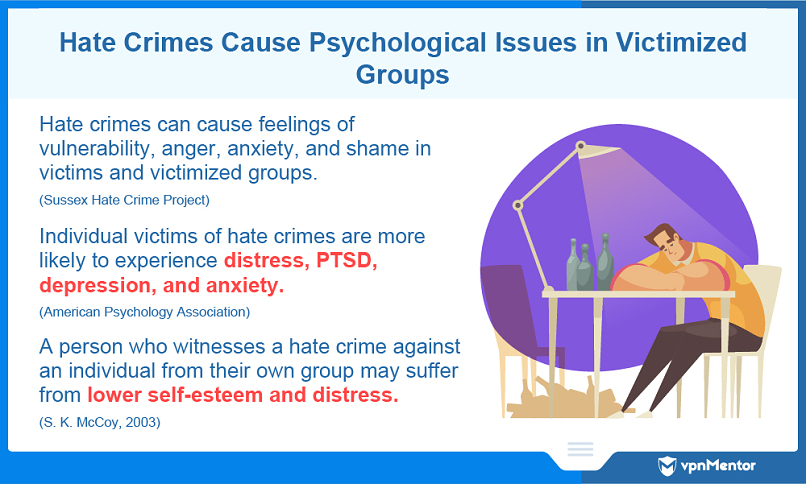
Even if hate crimes do not directly target other members of a group, they can still feel like a personal attack. By singling out a person for ridicule, violence, or theft because of their characteristics, other members of the victim's group who share the same characteristics are likely to feel targeted and unsafe.
Drug & Alcohol Abuse
How common is substance abuse among US students? And what effect can it have on their education? Here are the numbers on substance use in US schools and colleges.
70. The Prevalence of Drug Use at US Schools
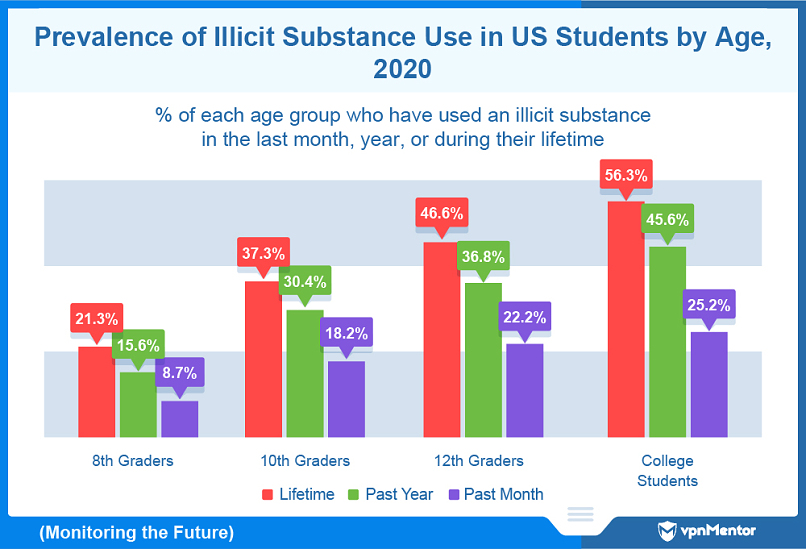
21.3% of 8th graders have used an illicit substance in their lifetime. That figure is 37.3% for 10th graders, 46.6% for 12th graders, and 56.3% for college students. As one might expect, the likelihood of students using drugs in the past year and past month increases consistently throughout each year group.
71. Drug Use in College Students vs. Other Youngs Adults
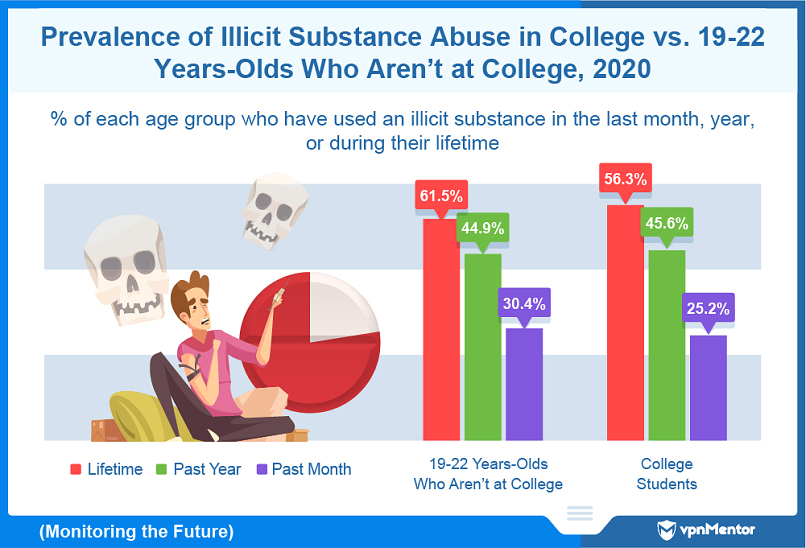
19-22 year olds who didn’t go to college report marginally higher levels of lifetime drug use than US college students, at 61.5% and 56.3% respectively. Studies have shown that substance use is linked with education inequality and low educational attainment. It's somewhat surprising that illicit substance use was only fractionally higher for 19-22 year old adults who aren't students.
College student drug use is still very high, of course, and “party culture” may be contributing to the these figures. Students often experience increased exposure to illicit substances at college due to increased binge drinking, social opportunities, and academic pressures (J. W. Welsh et al.).
72. Student Traits Influence Exposure to Drugs
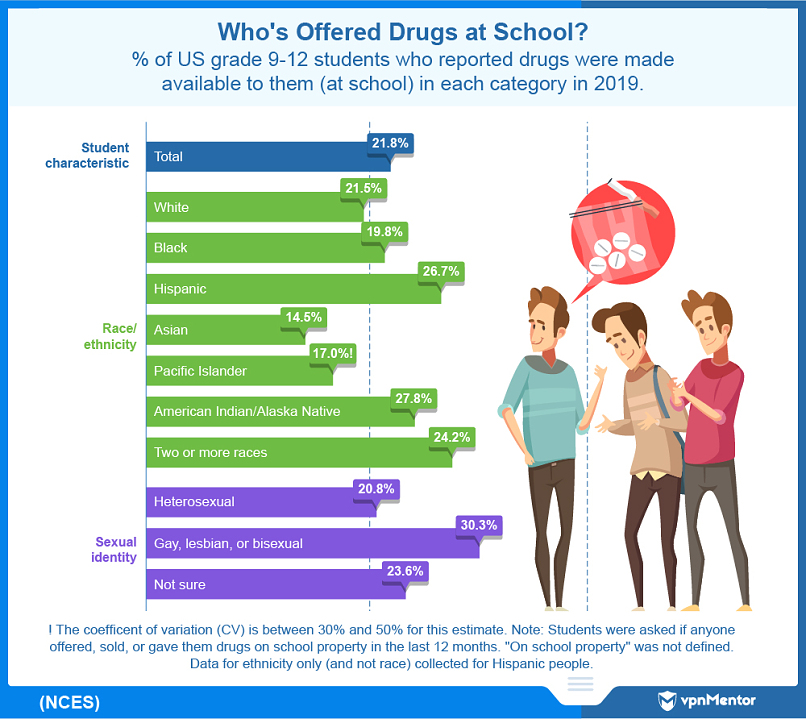
Nearly 22% of students claim drugs were made available at school in 2019 (the most recent data available). That figure increased slightly since 2017, when 20% of students reported that drugs were available on school property.
Hispanic, mixed race, and Native American students were more likely to be offered illicit substances in 2019. Meanwhile, students who identified as gay, lesbian, or bisexual are also likely to report being offered drugs at school.
73. Can Marijuana & Alcohol Use Lead to Other Substances?
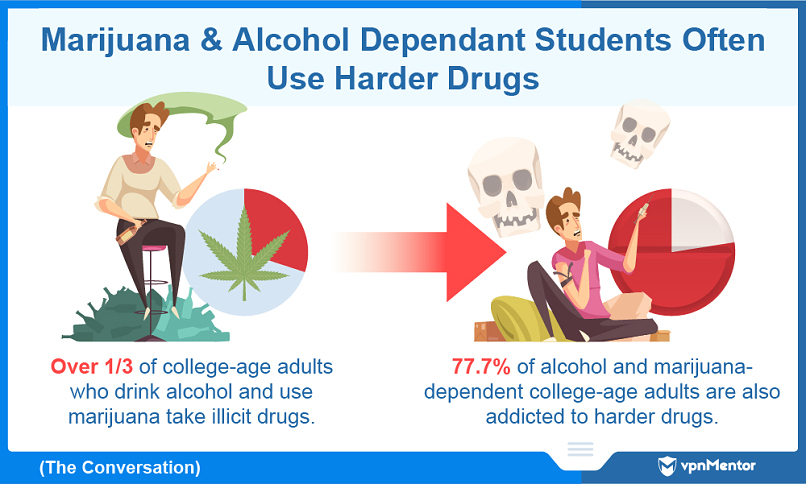
Marijuana is no longer an illegal substance in some US states. However, the numbers suggest that marijuana and alcohol use is linked to the use of other substances. Over one-third of cannabis and alcohol users also take illegal drugs, while nearly 80% of students addicted to cannabis and alcohol are hooked on harder substances.
74. Cannabis Use Among Students
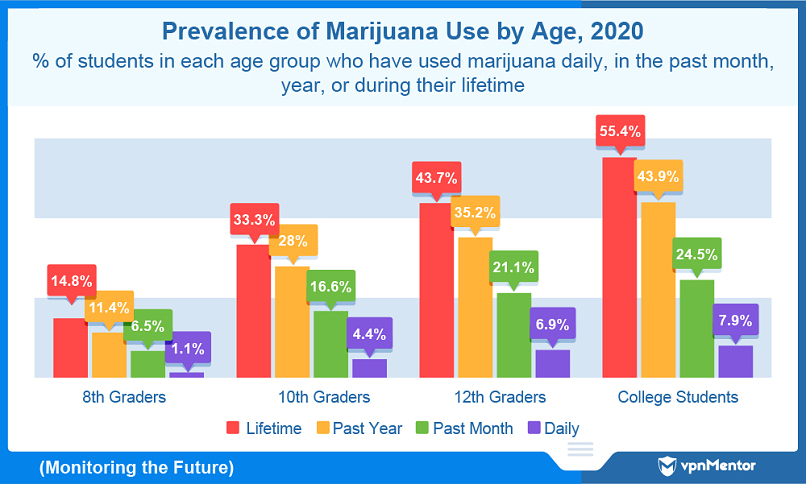
What proportion of students are currently using cannabis?
8th graders have the lowest level of lifetime cannabis use (14.8%). However, it's surprising that such young students are even using marijuana. College students, meanwhile, are the most likely group to have used cannabis (55.4%).
75. College Students: Prescription Drug Misuse
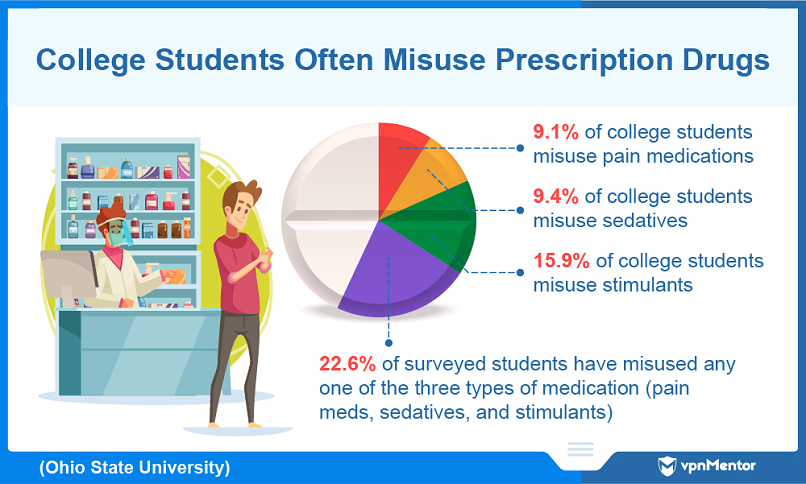
Ohio State's "College Prescription Drug Survey" found that the misuse of medications and prescription drugs is quite common among college students. Nearly one-quarter of students have misused prescription drugs.
76. College Students: Reasons for Stimulant Misuse
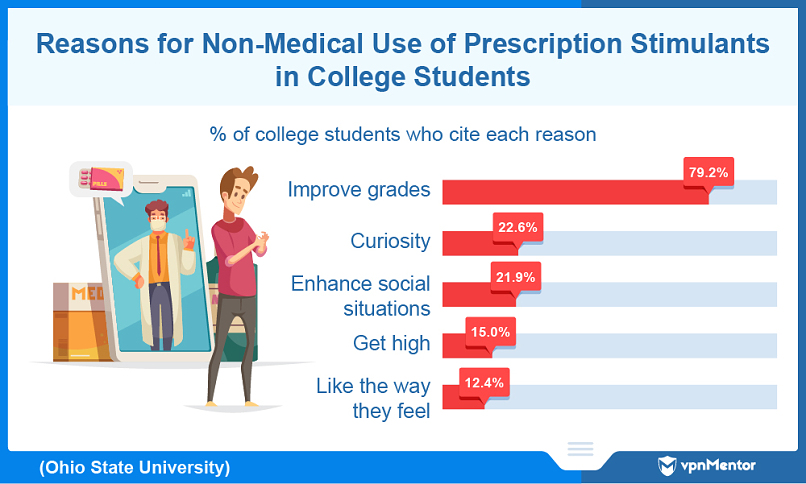
Why do college students choose to take prescription stimulants outside of medical prescriptions?
"Improving grades" was the reason cited by nearly 80% of college students. These students are likely using so-called "study drugs" like Adderall, Ritalin, and Modafinil to improve their focus.
Curiosity is a factor for some students, while others take stimulants to enhance their social skills or "get high." The smallest segment of respondents (12.4%) say they take prescription stimulants because they like how they feel.
77. College Students: Party Drug Use
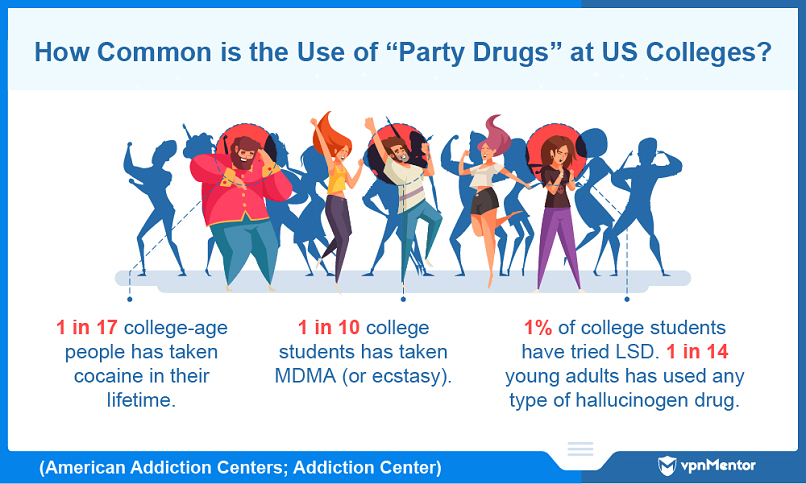
College students are often old enough to drink alcohol, go to parties, and go clubbing, resulting in experimentation with illegal substances.
Apart from marijuana (which is legal in several US states), the most popular recreational drugs amongst students are MDMA and cocaine. Methamphetamine and LSD are less common.
78. College Substance Abuse Treatment Is on a Downward Trend
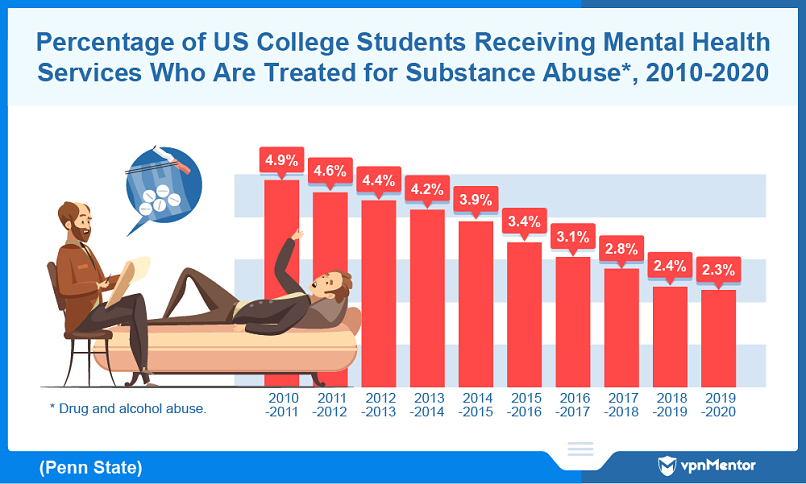
Drug and alcohol abuse among students is quite common. However, the number of students receiving mental health services for addiction has halved over the last decade.
4.9% of US students receiving mental health care were being counseled for issues with substance abuse in the 2010-11 school year. That figure was down to 2.3% in the most recent analysis by Penn State.
79. Alcohol-Related Crimes at College
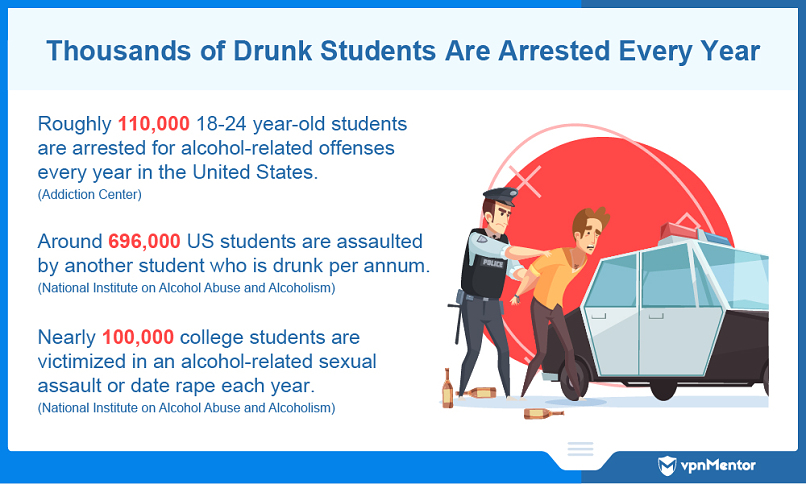
Binge-drinking (consuming a large number of drinks in a relatively short time) is common at colleges. According to government statistics, 53% of full-time college students drink alcohol every month. 33% of college students binge drink throughout a given month, and roughly 1 in 10 students has a drinking disorder.
Drunk and disorderly students cause millions of violations every year. Sexual assaults and fights are among the most common reasons for the arrests of drunken students.
80. Drug Abuse: Academic Impacts
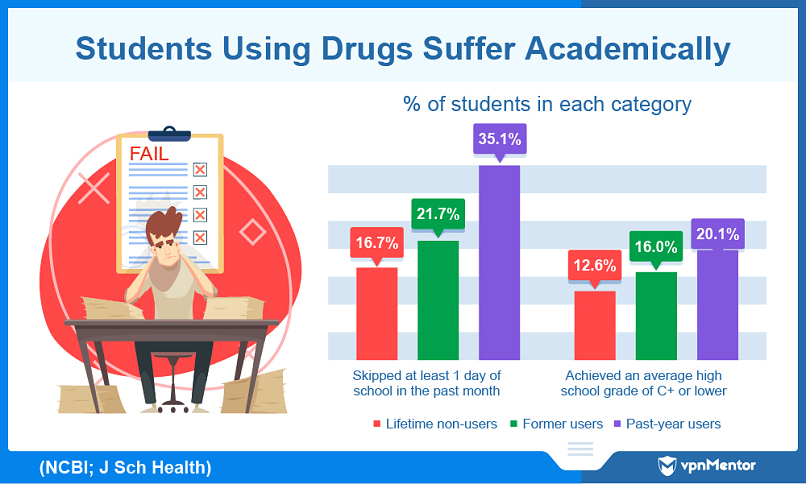
12th-grade students who used drugs at some point in the previous year were 2.71 times more likely to skip school than non-users. These past-year drug users were 1.71 times more likely to attain lower grades. Meanwhile, students who don't use drugs had better academic self-efficacy and engagement than past-year users.
That's because drug use can affect a student's concentration, judgment, memory, and focus. Partying and drug-taking can also lead to poor school attendance.
Geographical Differences
We lack comprehensive studies comparing school crime in the US vs. other nations. But from what we can gather, school crime rates in America are pretty middle-of-the-road compared to other countries.
That is for all crimes except one...
81. School Shootings: An American Problem
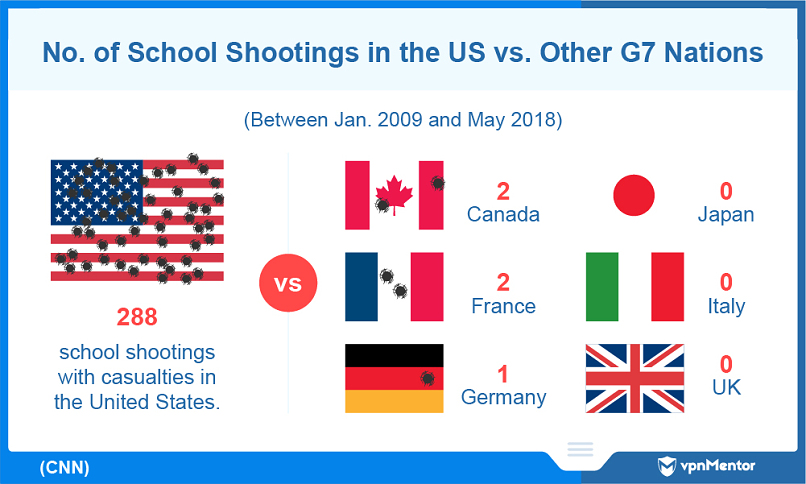
CNN analyzed 288 US school shootings between 2009 and 2018. America's record is appalling compared to other developed economies. The United States suffered 57.6 times as many school shootings as Canada, France, Germany, Japan, Italy, and the UK throughout this period.
These statistics are not entirely surprising when we dig a little deeper. Three-quarters of school shootings with 2 or more victims that occurred worldwide between 1991 and 2015 took place in the United States. According to UNICEF, the worldwide data shows that school shootings occur most frequently in nations with easy access to firearms.
82. Bullying Prevalence Around the World
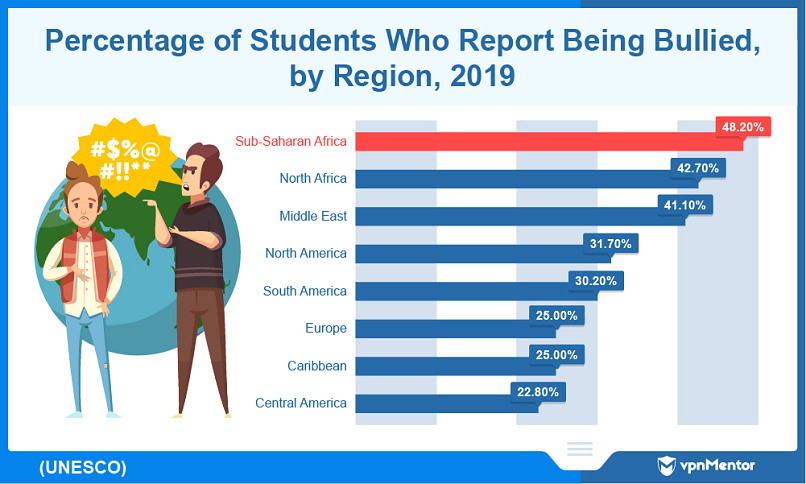
America is pretty average when it comes to bullying prevalence in schools.
In UNESCO's report, around 32% of North American schoolchildren claim to have been bullied. This is lower than the Middle East (41.1%), North Africa (42.7%), or Sub-Saharan Africa (48.2%), which was the region with the highest reports of bullying.
Meanwhile, Europe (25%), the Caribbean (25%), and Central America (22.8%) all have lower levels of bullying than the United States.
83. Bullying Type by Region
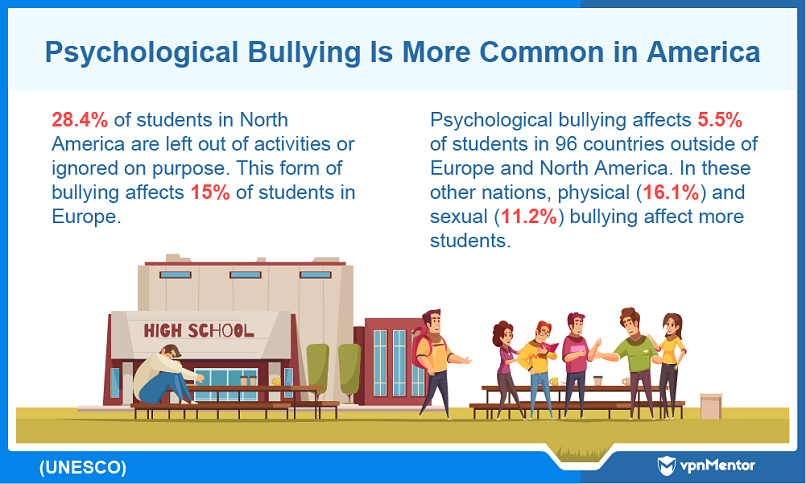
In 96 countries across Central America, South America, Africa, Asia, and Oceania, physical and sexual bullying are the most prominent forms students face. Physical bullying involves punching, pushing, and kicking. Sexual bullying includes being made fun of with sexual jokes, comments, and gestures.
On the contrary, psychological bullying (such as ignoring or leaving students out of activities) is the prevalent form of bullying in 48 countries throughout Europe and North America (plus Israel).
84. Cyberbullying Prevalence Around the World
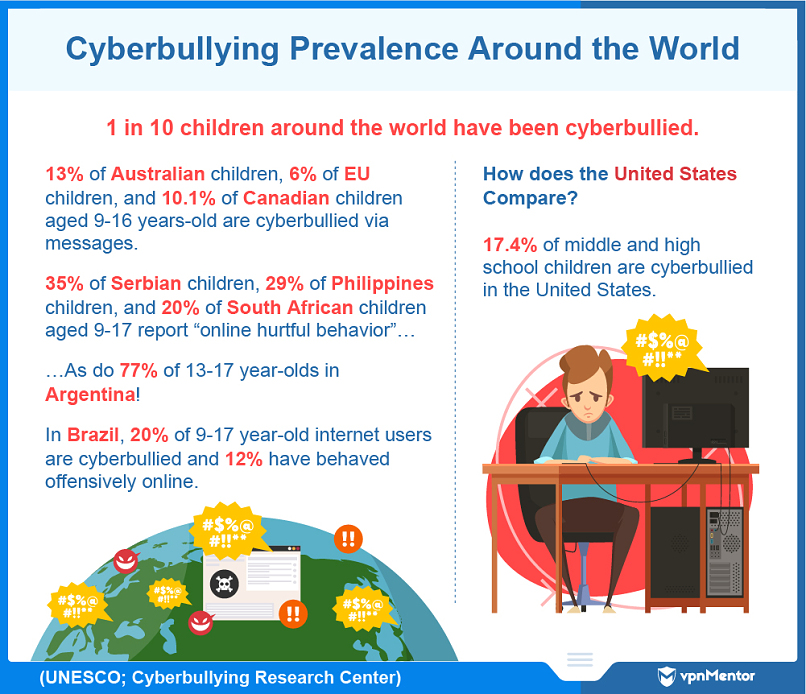
Although we lack a consistent global study on cyberbullying, the data we can piece together suggests that America has average levels of online bullying compared to the rest of the world.
That being said, America has slightly higher levels of cyberbullying than some other western cultures. Australia, Canada, and numerous countries in the European Union report a lower prevalence of cyberbullying among school-age children than in the US.
On the other hand, nations like Brazil, Argentina, South Africa, and the Philippines report a higher prevalence of cyberbullying than the US.
85. America and Abroad: How Common Are Physical Fights?
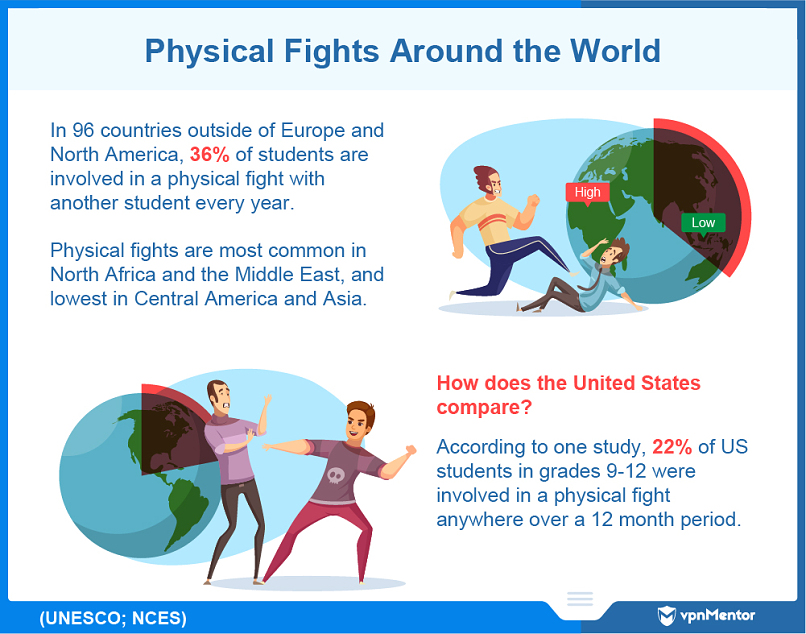
According to the data, around 22% of US students get into fights over a 12 month period. In other countries, fighting among students seemingly occurs at a comparable rate.
The Impact of COVID-19 on School Crime
School closures have significantly reduced the number of crimes being committed on school property. But the most up-to-date studies show that school crime certainly didn't stop because of COVID-19.
While we await updated statistics from the various government institutions that collect them, here's everything we could piece together on COVID-19's effect on US school crime.
86. School Shooting Incidents in 2020
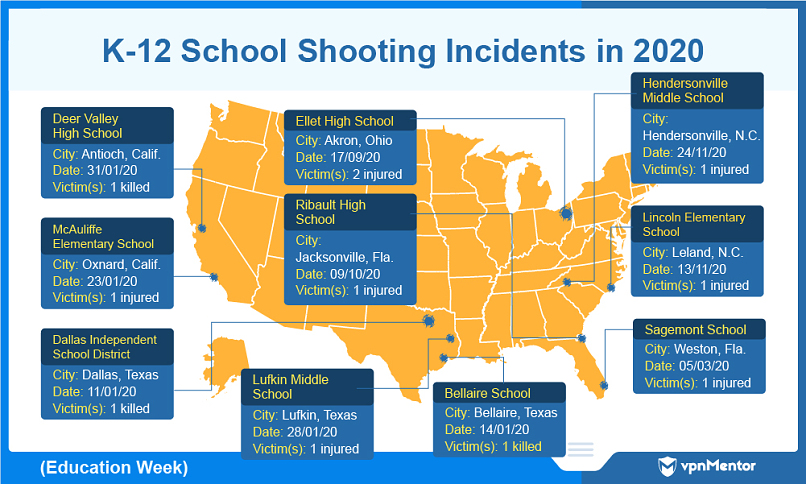
Education Week has been charting school shootings under their own criteria since 2018. Incidents must occur on active K-12 school grounds or buses during school time and involve at least one casualty.
There were 10 such incidents in 2020. As America grappled with COVID-19, school shootings did not go away.
Some of these incidents were covered extensively in the news, like the Deer Valley shooting. After a fight broke out in the school parking lot, 16 year-old Jonathan Parker was struck by gunfire and later died of his injuries.
87. 2020 School Shootings Breakdown
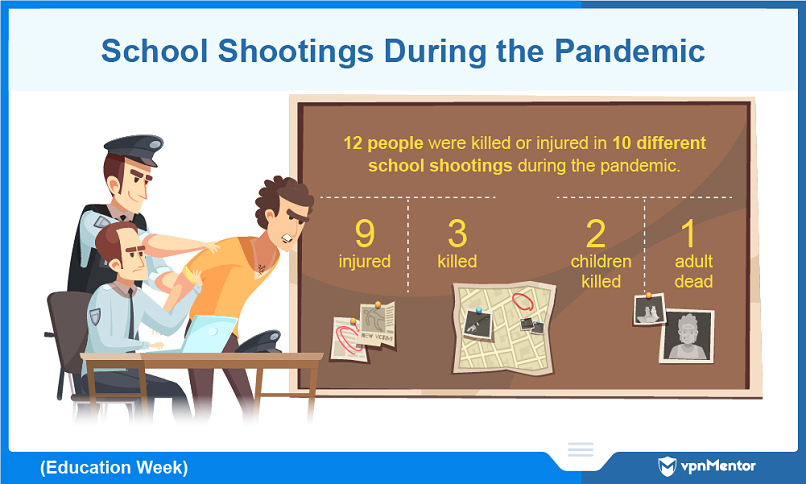
Under Education Week's criteria, K-12 school shootings with casualties fell from 25 in 2019 to 10 incidents in 2020. Other databases have shown a similar trend. Everytown Research found that incidents of gunfire on school or university grounds decreased from 130 in 2019 to 84 reports in 2020.
While figures from 2019 and 2020 show a drop in incidents, this data does not represent a general downward trend in school shootings.
Low pandemic figures are most likely representative of school closures, which reduced the amount of time students spent at school. Indeed, school shootings have occurred more frequently since schools reopened in March 2021 — a stark reminder that the problem has not gone away.
The Washington Post reported 14 school shootings between March 2021 and July 2021. That's the highest figure over that period since 1999. Altogether, there was a record number of school shooting incidents in 2021, according to the K-12 School Shooting Database.
88. Anti-Asian Hate Crime In US Schools Has Increased
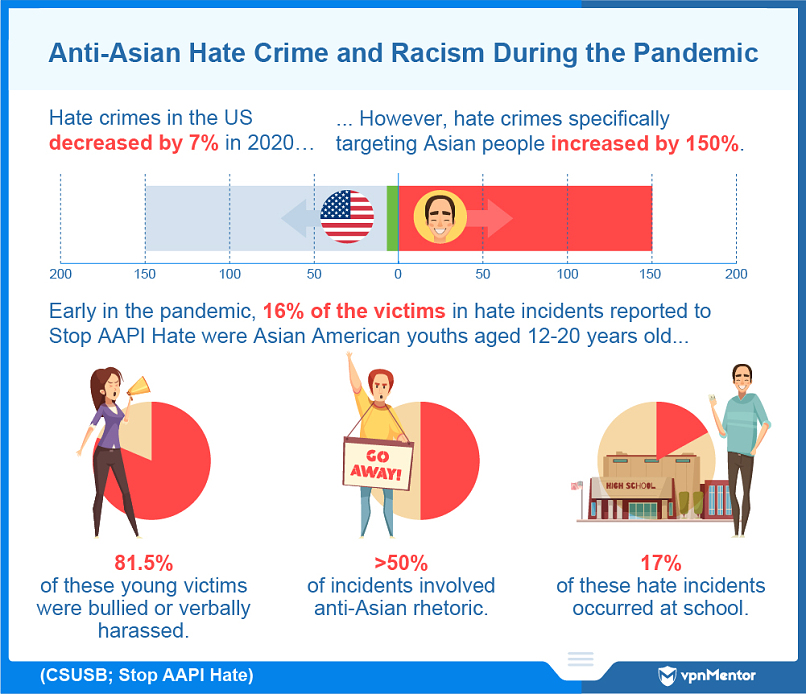
Racism and violence towards the AAPI community have seen a massive increase during the pandemic. As the virus was first detected in China, some people ignorantly assumed it had come from there — fuelled by widespread use of the racist and inaccurate phrase "The China/Chinese Virus." The AAPI community has suffered as a result.
In California alone, 264,000 Asian Americans were subjected to racist attacks in 2020.
Heightened levels of anti-Asian racism are visible among young people and students, too. "Stop AAPI Hate" notes that Asian American students returned to school at a slower rate than their peers. In February 2021, nearly 7 out of 10 Asian K-12 students were still using e-learning resources rather than in-person teaching. This hesitancy to return was attributed to fears of anti-Asian racism.
89. Cyberbullying Has Increased Significantly
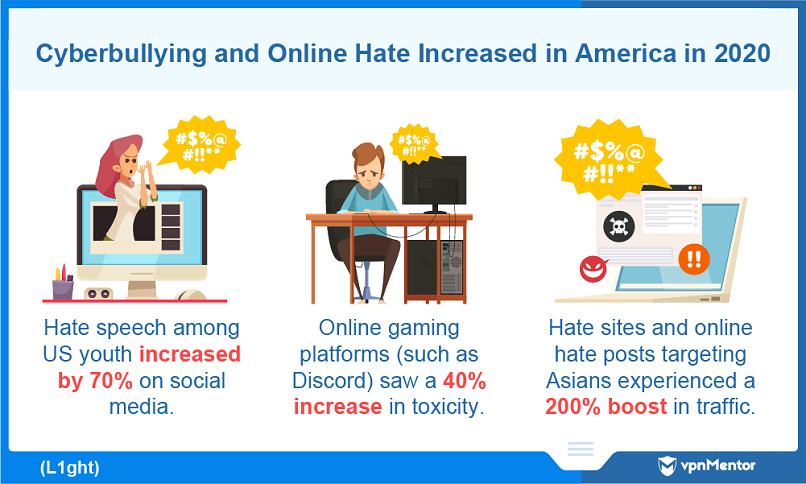
Research indicates that instances of in-person bullying saw a decline during the pandemic. The closure of schools throughout the United States prevented bullies from engaging in physical, sexual, or verbal harassment. Instead, students became targets of cyberbullying through online platforms: The early stages of the pandemic witnessed a significant surge in cyberbullying incidents among teenagers and children.
Contributors to School Crime
What characteristics in schools may influence the levels of crime seen in schools?
We've covered some of this in patches already, but here are 3 contributors to school crime.
90. Institutional Racism
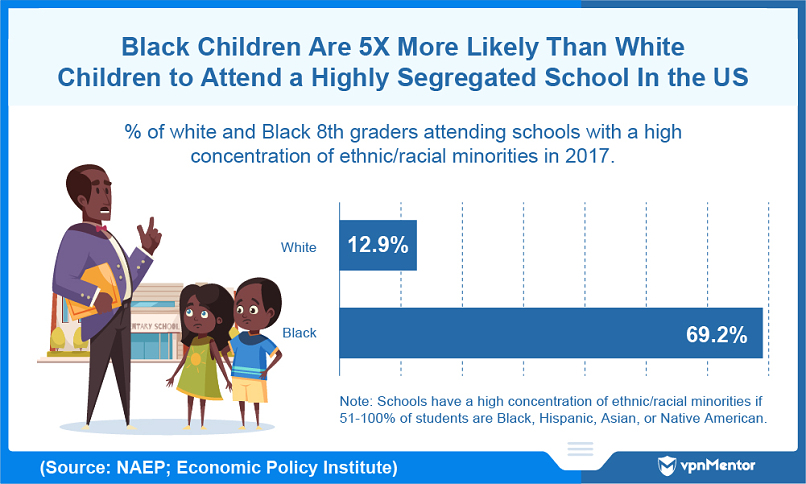
Even in 2022, schools in the US show signs of racial segregation. This points to the legacy of racism in US schools.
Segregation was outlawed in public education facilities in 1954. Yet, schools still see a hangover today, with nearly 70% of Black students attending a highly segregated school.
A lack of diversity in schools can prevent students from learning to be tolerant of other ethnicities, races, and cultures. According to a study from the University of Oxford, people exposed to diverse cultures and environments are often less likely to be racist to other ethnic groups.
91. Funding
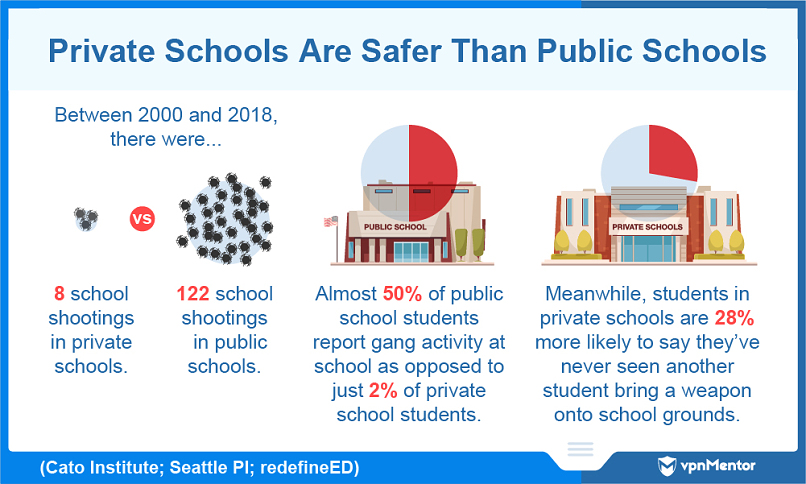
Private schools are better funded and can provide more support and security to students than public schools. Public schools in poor areas lack this privilege. According to the NCES, 36% of schools report that inadequate funding makes the biggest difference to crime prevention measures compared to any other factor.
Better safety measures mean private schools are often more difficult to breach. They're also less likely to be understaffed, so discipline can be more effective. There is also added support for each student.
92. School Size & Climate
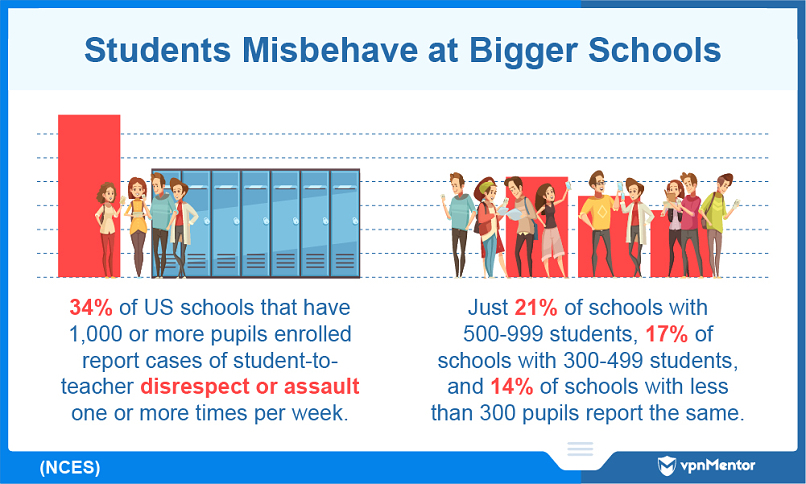
Larger schools have bigger year groups, which means both students and teachers are more anonymous. This leads to a general nonchalance among offenders and potential offenders — students are less affected by expressions of disapproval in this context of isolation (Toby, 1998).
The professionalization and specialization of educational institutions (schools focus on specific subjects or academic performance factors) mean schools often take pupils from larger catchment areas further away from their families and communities. This increases students' physical and psychological isolation, which increases the likelihood of criminal student behavior.
In other words, the data suggest that school climate has a significant effect on school crime. Students with less support are more likely to step out of line.
Tips to Prevent School Crime & Violence
How do we solve the issue of school crime in the US?
The answer to that question isn't straightforward. A multitude of individual, familial, school, and social factors can influence a student's behavior. No one person, let alone one teacher, can possibly understand every element of a student's life.
That being said, parents, school staff, and other community members can adopt some actionable steps to help minimize the impact of school violence and crime.
Enforce Discipline In & Out of Classrooms
Parents and school staff must enforce solid boundaries and discipline when students misbehave.
That's not to say parents and schools don't already take action when children and teens act inappropriately. But even in minor incidents, adults must "draw a line in the sand" to make sure a student's bad behavior doesn't escalate. We can all learn more about guiding childrens' behavior, and we can help others learn about proper discipline.
Cut out any stereotyping, prejudice, and racism in children, even if it's intended as a "joke." The same can be said for any other incident of misbehavior, bullying, hate, violence, and school crime. Set model behavior yourself and punish minors with strict measures when they break these rules.
Parents sometimes need to be educated too. Family support is massively important for a child's social and emotional development. A lack of proper guidance at home can lead a student down the wrong path, resulting in crime and violence.
When given the opportunity, you could speak with parents about the importance of upholding behavioral standards. This could be specific to the child. For example, if a student often calls other students horrible names, remind parents not to tolerate name-calling at home.
School staff and community members can also push for zero-tolerance policies within schools. Disciplinary measures in classrooms and at home may be futile if the school's disciplinary climate is below par. Clear rules and punishments must be upheld consistently across the entire school to better support students. Schools must adopt zero-tolerance policies towards incidents of crime, harassment, violence, etc.
Discuss Violence and Crime With Children
Adults can directly ask children for their opinions on big topics like violence and racism. You're not always going to receive a serious answer, of course, but addressing these issues can still be helpful.
Opening this dialogue can help you identify whether a child voices ethical or unethical opinions. These conversations also give adults a chance to teach students about the damaging effects of crime and the importance of reporting other children who bully, harass, attack, or carry weapons in school.
For teachers, these conversations can help build excellent communication with students and a sense of community in the classroom. Studies show these two factors can actively reduce students' chances of committing a crime.
Identify Warning Signs
Identify the warning signs of violence and misbehavior in students. Identifying warning signs early can allow you to step in and help a student before their behavior affects others.
If it's a student or child you know well, take notice of any changes in their conduct.
Educate yourself on signs that may indicate that a child needs help. For example, children who conduct violent acts often show several common characteristics during their youth:
- A lack of interest in education
- Mood swings, depression, and suicidal thoughts
- Agitation and a lack of self-control
- Signs of despair and isolation
- Talks about bringing weapons to school and/or not fearing death
- An obsession with violent games or movies
- Commits random acts of violence towards animals/creatures
Behavioral Intervention Programs
If a minor displays concerning behaviors, parents and school staff may decide that behavioral intervention programs are the best source of help.
Some programs offer 1-on-1 behavioral counseling to students. Importantly, this can help students work through issues that might be causing them to lash out.
There are also programs that teach children important life lessons. The “Becoming A Man” course from Youth Guidance is an excellent example of an effective behavioral intervention program. Becoming A Man helps youths who are at risk of violent encounters, either because of their schools or the communities where they live. The course teaches students how to deescalate violent situations with various skills in their "toolbox," such as negotiation skills. According to trials from Crime Lab, the Becoming A Man course reduces arrests for violent crime in participants by 45-50%.
Encourage Anonymous Student Reporting
Anonymous student reporting systems in schools allow students (and sometimes school staff and other adults) to report inappropriate behavior from students, staff, or community members without the reporter revealing their identity. Anonymous student reporting is often done via a written form, helpline, or online platform. A student might report another person for bullying, harassment, hate speech, or sexual assault.
Anonymous student reporting is already implemented in numerous US schools and was even a recommended measure in a government bill titled: "Student, Teachers, and Officers Preventing School Violence Act of 2018."
Children may find reporting an incident to the police or a teacher intimidating, especially if students fear retaliation from the offender in their class. Anonymous student reporting works because it alleviates these fears.
We've seen student reporting prevent various high-profile school crimes over the years. In 1997, a Mississippi high school student reported a classmate they knew was planning a school shooting. The armed classmate was later apprehended, and a potentially devastating attack was avoided. Over 20 years later, anonymous reporting is only just seeing widespread adoption in schools. Still, there are schools without such systems in place. If your local school does not use any form of anonymous student reporting, it's worth pressuring school officials to implement this measure.
It could save students' lives.
Join a Violence Prevention Coalition
Violence prevention coalitions support at-risk students and offer community-led solutions to crime and violence in schools.
These groups actively work to reduce violence and crime within schools and communities. According to the National Crime Prevention Council research, crime rates can be reduced by up to 30% when violence prevention efforts take a community-wide approach.
Schools Need a Violence Prevention & Response Plan
Every school should have a violence prevention and response plan — especially for incidents of gun violence. More than 9 in 10 schools have a written plan for managing active shooter incidents (NCES).
Violence prevention teams can identify and mitigate risk factors before turning into a crisis. In a genuine emergency, a response plan is crucial to keep other students safe.
Prevention and response plans may include school safety procedures and policies, warning signs, and intervention strategies, not to mention steps for the optimal crisis and post-crisis response.
Increase Funding for Schools
Many schools in the US face teacher shortages and dilapidated school facilities; classrooms may even lack necessary supplies, such as whiteboards or functioning computers. These factors can reduce the quality of education and support available for students.
Communities can come together to help underfunded schools and overworked teachers. Donating or raising money for schools can improve teacher-to-pupil ratios, and students can have better access to resources — improvements that could help students attain better grades and actively reduce their chances of committing a crime.
Local fundraisers are a great way to raise money for your community's school. Community members can hold bake sales, raffles, and "check writing campaigns" that encourage locals to donate to the school's cause.
Voluntary donations via charities and non-profit organizations are an option too. On sites like DonorsChoose.org, you can help fund individual teachers’ projects in your area.
Donations and fundraisers on a local level can help fund solutions to specific problems within your neighborhood's school. For example, a fundraiser could be dedicated to "fixing the school fence," which would help keep the school playground safer from outsiders. Or perhaps the added budget could be used to hire more teachers and reduce classroom sizes.
You can also donate to US education on a district or national level. If you plan to donate to your school district, it's best to contact district representatives to find out "where" you should donate and "what" the district's schools need help funding. You could also donate physical items to schools in a district yourself, such as "X amount of whiteboard markers" or "Y amount of paper towels."
If you want to donate to a nationwide initiative, charitynavigator.org is an excellent place to find a reputable cause. You can help fund all manner of US education charities and non-profit organizations that cover initiatives like student support programs, education/policy reforms, and classroom support.
Work to Influence Legislation
Crime prevention is a field of research that's constantly developing. There's a continuous stream of new and improved data covering local and national incidents. Legislation must keep up with changing attitudes and trends in school crime. That's why legislative changes and reforms to policies on a local, state, or national level are necessary for school crime prevention and policing.
People can come together to protest legislation after high-profile criminal incidents that potentially highlight deficiencies in US law. The "March for Our Lives" protest that followed the Stoneman Douglas High School shooting in 2018 is one example. In the March for Our Lives, 3,000 people protested gun laws in the United States.
How else can you highlight legislative issues? For a start, you could speak with other community members who share your concerns.
Several voices are louder than one, and community members can also help you gain exposure in different ways. You can also promote a petition on social media, contact your local newspaper to write an editorial, or even write directly to local legislators to advocate for policy reforms.
The Bottom Line
Most crimes in US schools have decreased massively over the last 20-30 years, but that's not to say there isn't still cause for concern. Some crimes — in particular, school shootings and mass homicides — have seen a rapid increase instead. What can be done about such a horrific and uniquely American problem?
Schools are a microcosm of society, and crimes in US schools ultimately reflect broader societal issues in the United States. Until we find solutions to America's problems, people will continue to scrutinize the safety of US schools.
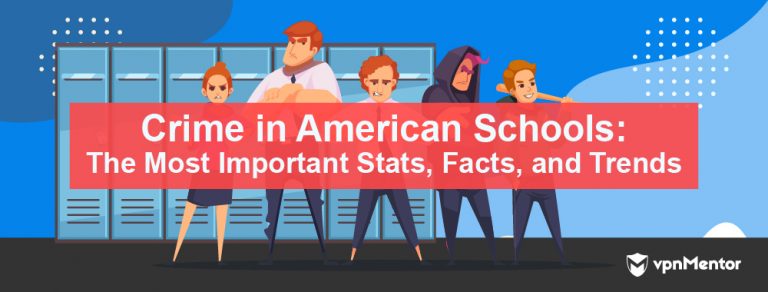



Please, comment on how to improve this article. Your feedback matters!